Samsung The Frame LS03D (2024) is not just an ordinary TV that you place in the corner and forget about after two days. Right away, it’s clear that the manufacturer aimed for more than just displaying movies. First, the "Art" mode grabs attention – with just a few clicks, we can turn The Frame into a digital gallery, showcasing works that, combined with the matte screen, really resemble a real painting in a frame. Speaking of frames, we have the option to customize its colour to perfectly match our interior. Additionally, in the package, we’ll find a wall mount, which allows the TV to be hung virtually “flat”, enhancing the impression of engaging with a piece of art rather than a typical screen. The matte display provides great protection against light reflections, and paired with high brightness (650 cd/m²), it performs well even in full sunlight. On top of that, we have a VA panel with quite decent contrast and a refresh rate of 120 Hz, so watching sports or playing dynamic titles looks really smooth and pleasing to the eye. Adding to this are the gaming features – VRR, ALLM, and HGiG – indicating that Samsung also thought about console and PC fans. As a result, Samsung The Frame can serve as both a picturesque decoration for the living room and a rather sensible gaming monitor. The mentioned One Connect is another handy gadget – it allows us to hide all cables in one place, requiring only a thin cable connecting the TV to that magic box. If we like order, this is a solution designed for us. Another advantage is the Tizen system – easy to use, fast, and full of apps. While it may not have absolutely everything (e.g., the Tidal app), it still offers a wide range of options when searching for additional streaming platforms. Of course, there’s no rose without thorns. The lack of local dimming is noticeable in dark scenes, where the blacks become less distinct. We also have to remember that there’s only one HDMI 2.1 port, so if we want to connect more devices at 4K and 120 Hz, we might feel limited. Besides, the viewing angles are rather average, so it’s better if the most important viewer (that’s us) sits directly in front of the TV. For Dolby Vision lovers, it won’t be the ideal choice either, as The Frame LS03D only supports HDR10 and HDR10+. Additionally, the sound – like in most slim TVs – is average, so it’s worth considering a soundbar if we care about clearer bass and a deeper sound. Despite these weaker points, The Frame still makes a great impression. It’s striking, stylish, and versatile – suitable for both watching the latest hits and displaying reproductions of paintings on the wall. If we value an extraordinary appearance, high brightness, and want to play something with low input lag, then this model will be a perfect choice. And while it may not be the leader in cost-effectiveness nor a technological "monster" in terms of picture quality, it has something that is simply likable. It’s a piece of equipment that stands out with its unique character and can fit into any interior, attracting attention both in TV mode and digital art gallery mode.
- Matching (Score)
- Our verdict
- TV appearance
- Where to buy
- Contrast and black detail
- HDR effect quality
- Factory color reproduction
- Color reproduction after calibration
- Smoothness of tonal transitions
- Image scaling and smoothness of tonal transitions
- Blur and motion smoothness
- Console compatibility and gaming features
- Input lag
- Compatibility with PC
- Viewing angles
- TV efficiency during daytime
- Details about the matrix
- TV features
- Apps
- Playing files from USB
- Sound
Samsung The Frame LS03D vs TCL C8K
Direct compare
The Frame / LS03D
C8K / QM8K

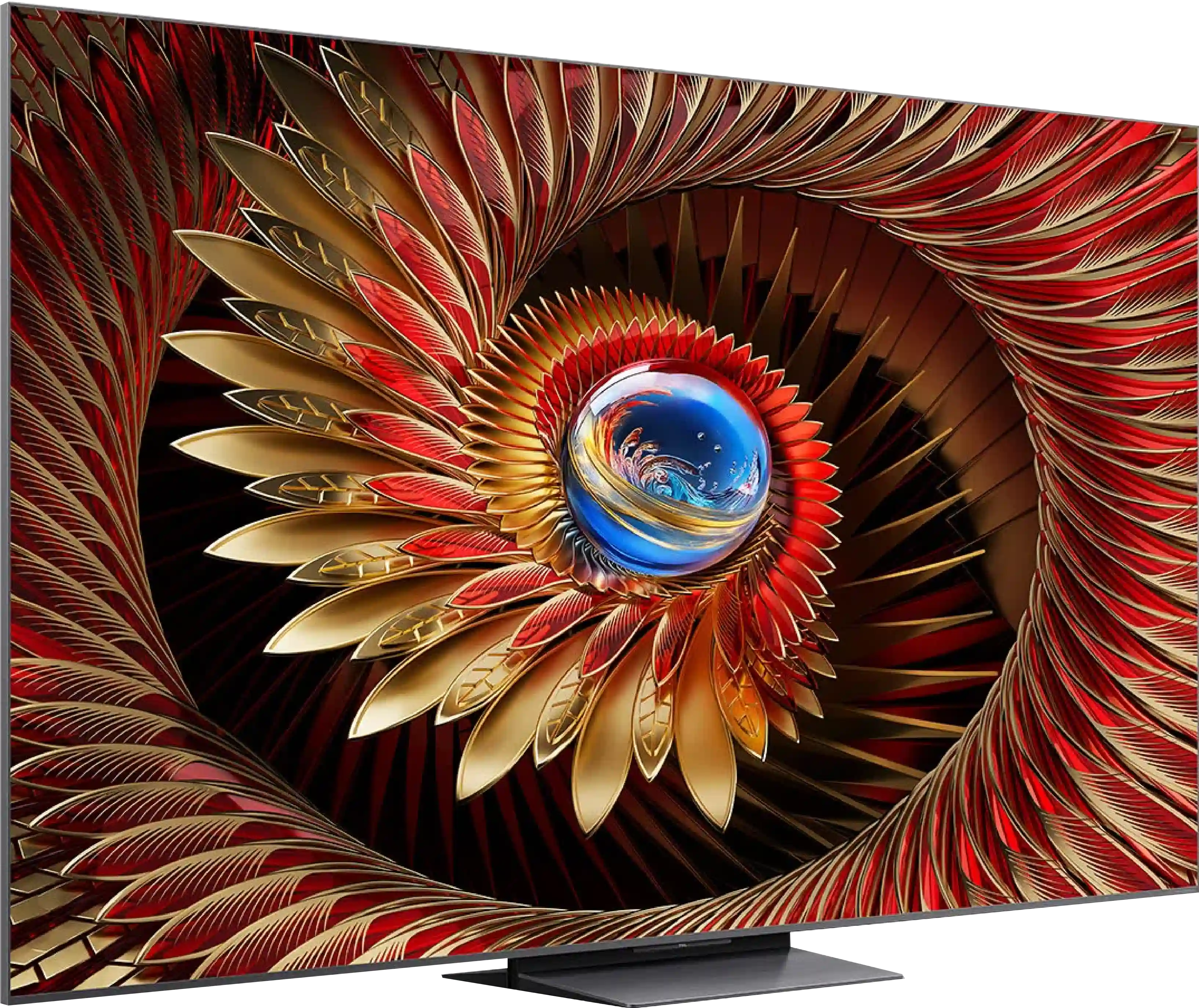
Panel type: LCD VA
Resolution: 3840x2160
System: Tizen
Model year: 2024
Complete the survey to find out the result

Panel type: LCD VA
Resolution: 3840x2160
System: Google TV
Model year: 2025
Complete the survey to find out the result

Overall rating
7.0
7.7
Movies and series in UHD quality
6.9
7.4
Classic TV, YouTube
6.5
7.0
Sports broadcasts (TV and apps)
6.2
6.8
Gaming on console
8.2
8.9
TV as a computer monitor
7.6
8.6
Watching in bright light
6.5
6.9
Utility functions
7.8
7.7
Apps
8.7
9.6
Sound quality
5.8
7.9
Complete the survey to find out what fits your preferences
Advantages
Unique design and "Art" mode – the television perfectly blends into interiors and serves as a digital picture frame
Matte screen – effectively reduces light reflections
Customisable television frames – adjusting the look to fit the interior
Dedicated wall mounts included (Value approx. AUD 400) – the television can sit almost flat against the wall
High brightness (650 cd/m²) – excellent visibility even in well-lit rooms
VA panel – decent contrast
Good motion fluidity – 120Hz*
Supports VRR, ALLM and HGiG – full package of gaming features
Smooth tonal transitions – one of the best results in this category among tested televisions
One Connect module – minimises cable clutter, ensuring tidiness
Tizen system – responsive, intuitive
*Does not apply to the 43 and 50-inch variants (60Hz)
Great contrast and black levels
Very high HDR brightness
Support for all popular HDR formats
Fast 4K@144 Hz panel
Many features for gamers (VRR, ALLM, Game Bar, Low input lag)
GoogleTV operating system with many apps
Improved viewing angles thanks to WHVA panel
Very good sound: Collaboration with Bang & Olufsen
Disadvantages
No local dimming – affects the quality of black, especially in dark scenes
Average viewing angles – the image loses quality when viewed from a greater angle
Average sound quality – flat sound without depth
Limited number of HDMI 2.1 ports – only one port supports full 4K@120 Hz
No Dolby Vision – the television only supports HDR10 and HDR10+
No smaller variants, e.g. 55"
Very weak dimming algorithms
Colour reproduction out of the box needs improvement
Only 2 HDMI 2.1 ports and one USB.
No recording function from built-in tuners and PiP
Our verdict
The C8K is proof that premium Mini LED technology doesn't have to cost as much as a premium product. With a high number of dimming zones and a new WHVA panel, the television offers excellent contrast, deep blacks, and very high brightness – everything we expect from a good viewing experience in the living room. The improved viewing angles are also impressive, as they no longer detract from the enjoyment of watching when sitting outside the centre of the frame. The C8K also shines in the gaming world – with a 144 Hz refresh rate, support for 288 Hz in Full HD, a full set of gaming features, very low input lag, and sensible compatibility with PCs, it's hard to put down the controller or keyboard. It also comes with Google TV – currently the most advanced and versatile Smart TV platform. There is access to all the key apps, great voice control, and an intuitive interface. It may lack some classic TV features like USB recording from built-in tuners or picture-in-picture (PiP), but most users won't even notice that. On top of all this, the sound is quite decent – a new collaboration with Bang & Olufsen.
Of course, it's not a screen without its flaws. HDR, while impressive, still has some 'mini LED' traits – bright scenes can be overly bright or dimmed, and the system lacks a few classic features known from other brands. But when we consider its price in comparison to the competition, it's hard not to ask the question – why pay more?
TV appearance





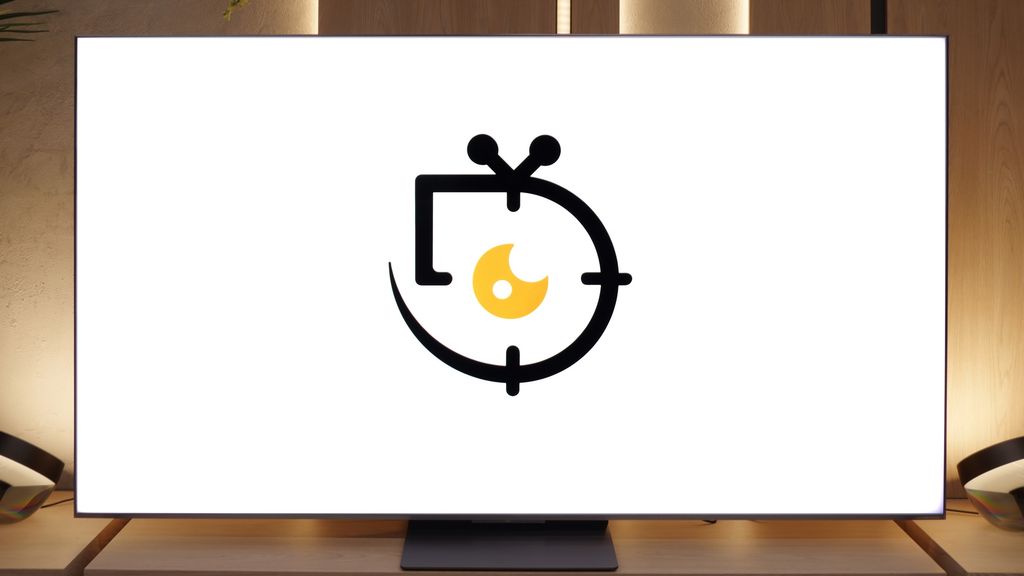
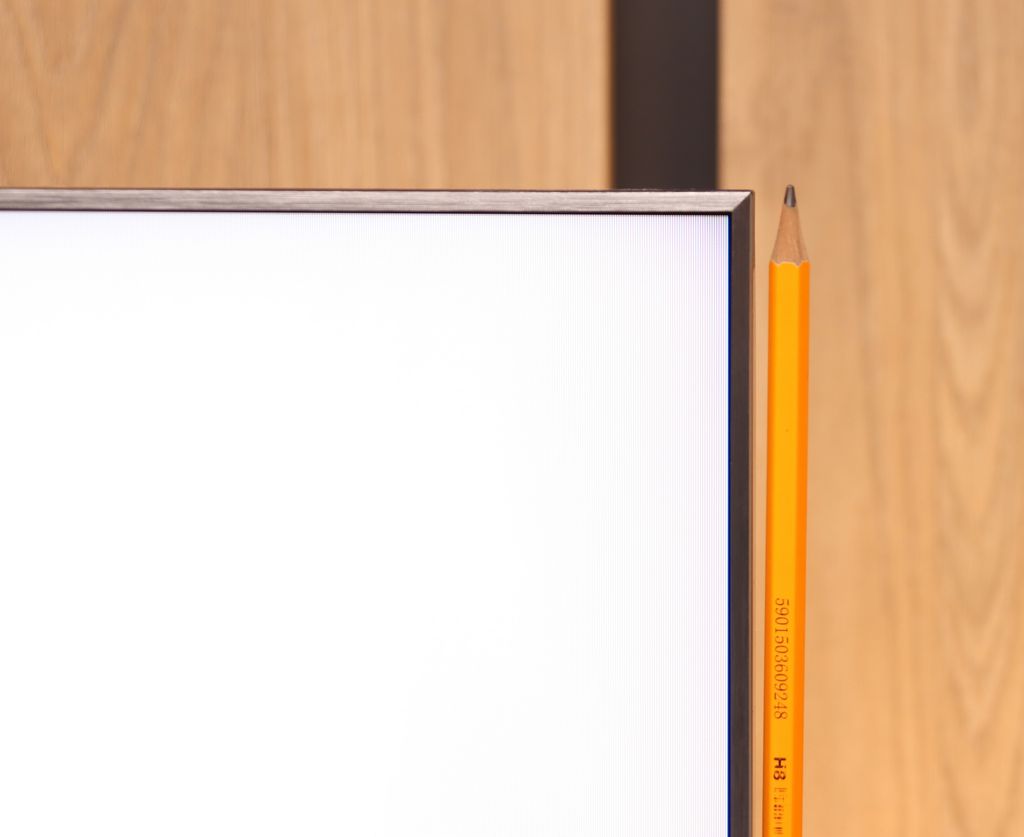
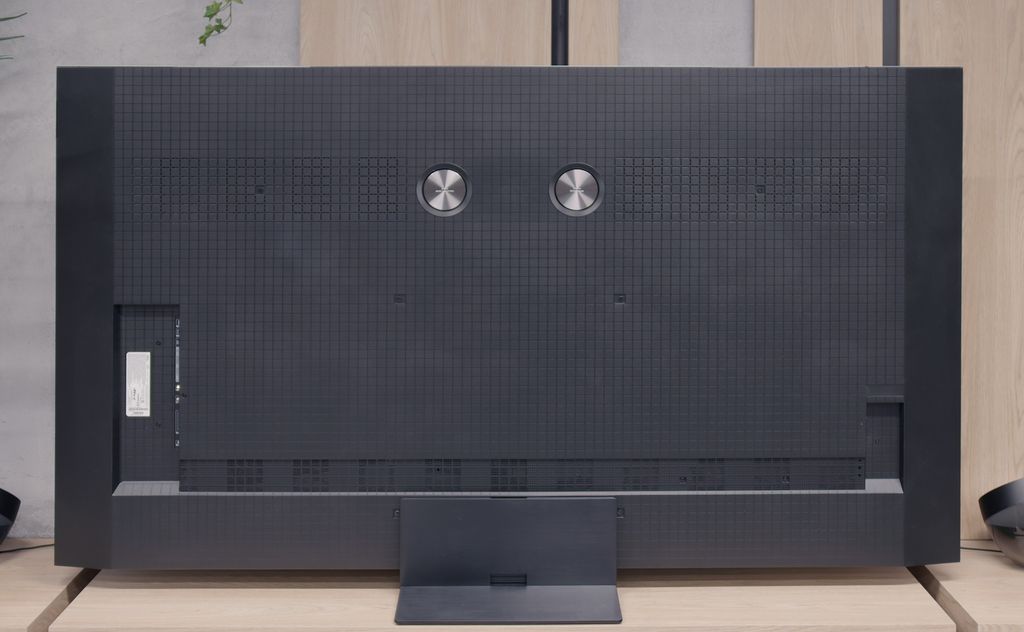
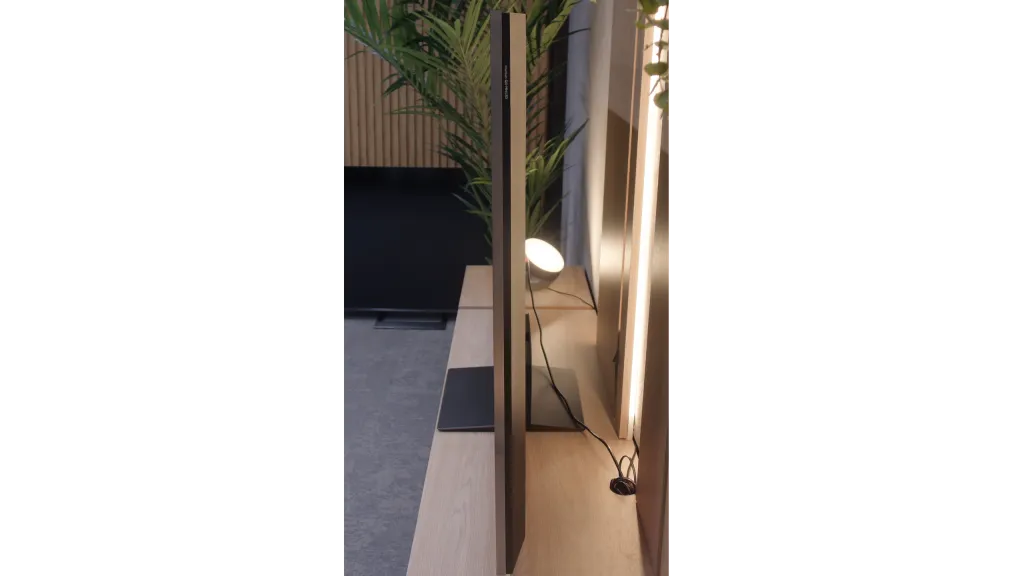
Contrast and black detail
5.6/10
8.2/10
Local dimming function: No
Local dimming function: Yes, number of zones: 1680 (30 x 56)
Contrast:

Result
4,200:1

Result
4,800:1

Result
5,100:1

Result
5,300:1

Result
3,850:1

Result
714,300:1

Result
68,100:1

Result
25,050:1

Result
17,800:1

Result
12,500:1
Halo effect and black detail visibility:

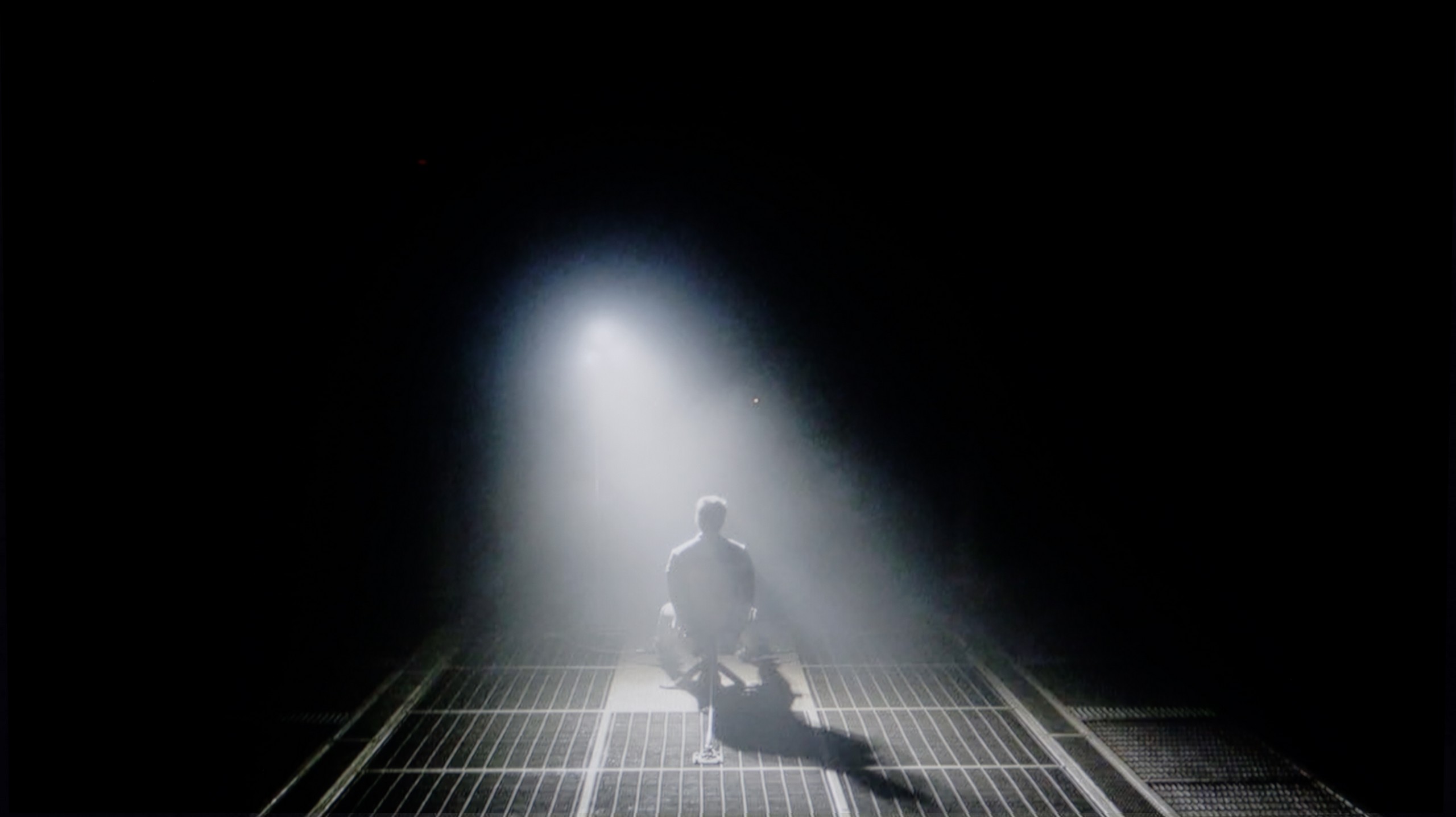
Samsung The Frame uses a VA panel, which provides quite a high contrast on its own. In our tests, the results ranged from 4000 to 5000:1, which will be perfectly sufficient for most users. However, the lack of local dimming becomes apparent, especially on more demanding test patterns. In dark scenes, it can be noticed that the black has a slight navy hue. During the day or in a well-lit room, this won't be a problem, but during an evening viewing, more demanding viewers may feel a slight dissatisfaction.
TCL C8K is a representative of the Mini LED class of TVs and – importantly – it uses a VA panel. This means high native contrast right from the start, but the true strength of this model reveals itself only when we combine it with an impressive number of dimming zones. In the 75-inch version we tested, we counted nearly 1700 independent zones – and you can feel it. In many scenes, the effect of black levels and contrast is nothing short of phenomenal. In less demanding scenes – where dimming algorithms don’t have to “work hard” – the screen can resemble OLEDs. The contrast can be nearly infinite, and the separation between bright and dark elements makes a fantastic impression.
However – as is often the case with Mini LEDs – this is not an organic screen, and some compromises have to be expected. Brightness is a huge asset, but it can also reveal the weaknesses of this solution – especially in dark scenes. Parts of very challenging scenes to display – such as those famous ones with a starry sky or sequences from the iconic Pioneer Kuro – become noticeable with what’s known as haloing, which is a glow around small bright details. Sometimes the whole screen also lightens slightly when the system tries to reconcile contrast with extreme luminance. However, this is a characteristic of the technology, not a flaw of a specific model. And although such compromises can somewhat diminish the final impression in certain scenes, TCL C8K is among the very best when it comes to contrast among Mini LED TVs.
HDR effect quality
6.4/10
6.9/10
Luminance measurements in HDR:

Result
679 nit

Result
663 nit

Result
712 nit

Result
698 nit

Result
726 nit

Result
1241 nit

Result
510 nit

Result
1180 nit

Result
375 nit

Result
1421 nit
Scene from the movie “Pan” (about 2800 nits)


Scene from the movie “Billy Lynn” (about 1100 nits)


Static HDR10


Dynamic: HDR10+
Dynamic: Dolby Vision


HDR luminance chart:
TCL C8K
HDR luminance
Samsung The Frame LS03D
HDR luminance
Samsung The Frame LS03D really does well with brightness. Results at the level of 700 nits make bright elements on the screen look impressive and detailed, whether they illuminate the entire screen or appear as tiny points of light on a dark background. In more demanding scenes, like the fourth sequence from the film Sicario 2, the blacks perform moderately, but we have already discussed this in the section on contrast. However, when it comes to brightness – this television definitely holds its own. An additional advantage is the quantum dot coating, which is QLED technology. Thanks to this, the coverage of the colour palette has been improved, although The Frame does not stand out in this regard compared to the competition.
TCL C8K is a really bright television. In synthetic conditions – that is, during tests with brightness charts – it was able to achieve even 3500 nits peak brightness in movie mode. That's an impressive result and brings the C8K close to the market leaders, at least when it comes to panel brightness. More importantly – these aren't just numbers on paper. In films with a lot of bright scenes, such as Life of Pi or The Meg, the brightness clearly exceeds 1000 nits, providing a true sense of HDR effect. The picture in those moments looks very dynamic, colors are saturated thanks to excellent coverage of the color palette, and the lights are – spot on and intense. Exactly how it should be.
However, this doesn’t mean that everything is perfect. Just like in contrast tests, here too, in more demanding scenes, compromises appear. In sequences with very fine light elements – such as stars in the night sky or reflections in dark rooms – the local dimming algorithm can… get confused. Instead of bringing those details up, the television sometimes decides to dim them significantly – down to around 300 nits – to maintain deep blacks. On one hand, this is quite a sensible approach (better deep black than a grey/navy blue screen), but on the other – there may be moments when certain elements of the picture become difficult to see or even disappear into darkness.
TEST UPDATE (20/08/2025): The brightness control algorithm in this model is quite problematic – attempting to calibrate the picture so that it doesn’t drastically overexpose the brightest scenes results in unnatural shifts: improvement in one part of the image results in deterioration in another. The television may achieve slightly higher readings in brightness measurements, but in practice, this comes with a heavily overexposed image that looks very unnatural!
For the record, we provide brightness values without this adjustment:
1463 nits
640 nits
1368 nits
468 nits
1025 nits
Factory color reproduction
7/10
4.8/10


Factory Mode
After calibration


Factory Mode
After calibration
Samsung offers several picture modes in its televisions, but without a doubt, Filmmaker Mode is the one that should provide the most natural representation of content. Unfortunately, as often happens with mass production, the differences between individual units can be quite significant, and our tested model did not escape a few issues.
In the case of SDR content, the white balance leaned heavily towards red, with a slight boost in blue. This effect was particularly noticeable in comparison photos – for example, in a photograph of a boy whose face was unnaturally flushed. The gamma, or brightness characteristic, also did not perform perfectly – the image was slightly brightened, which robbed it of depth.
In 4K HDR content, the white balance was once again dominated by red, this time combined with green. Meanwhile, blue clearly lost intensity, which could easily be seen on the Color Checker palette, where the colours began to "escape" in the wrong direction. The EOTF curve, responsible for brightness in HDR content, showed that the television tended to overly brighten the image, particularly in the darkest elements of scenes.
Overall, while it did not look terrible, it definitely required correction. Fortunately, Samsung offers extensive calibration options, which provides a chance for a significant improvement in picture quality. Therefore, we proceeded with professional calibration to unlock the full potential of this television.
In the C8K, a new picture mode has appeared: Filmmaker Mode. This is something we've known for years from televisions of other brands – a mode designed to deliver the director's vision as faithfully as possible, without unnecessary image enhancements. Unfortunately, at TCL, it seems to still be in the "to be refined" stage. Right from the first glance, the screen appears too warm – the image veers into reds, which may not appeal to everyone. The white balance was markedly skewed – the screen looked distinctly warm, and the red colour dominated almost every scene. There was a lack of blue, which led to an unpleasant yellowing and distortion of the image. But that’s not all. Regardless of whether we were watching regular TV, YouTube, or HDR films – the television had a clear tendency to excessively brighten the image. In tests of gamma curves and EOTF, the lines strayed instead of adhering to the standard, resulting in an overly bright and less contrasting image. Additionally, in colour reproduction tests, significant deviations were noticeable – on the colour wheel, some points were actually "drifting away." It must be said plainly: Filmmaker Mode in the C8K, in its current form, is not very cinematic.
Color reproduction after calibration
8.1/10
7/10

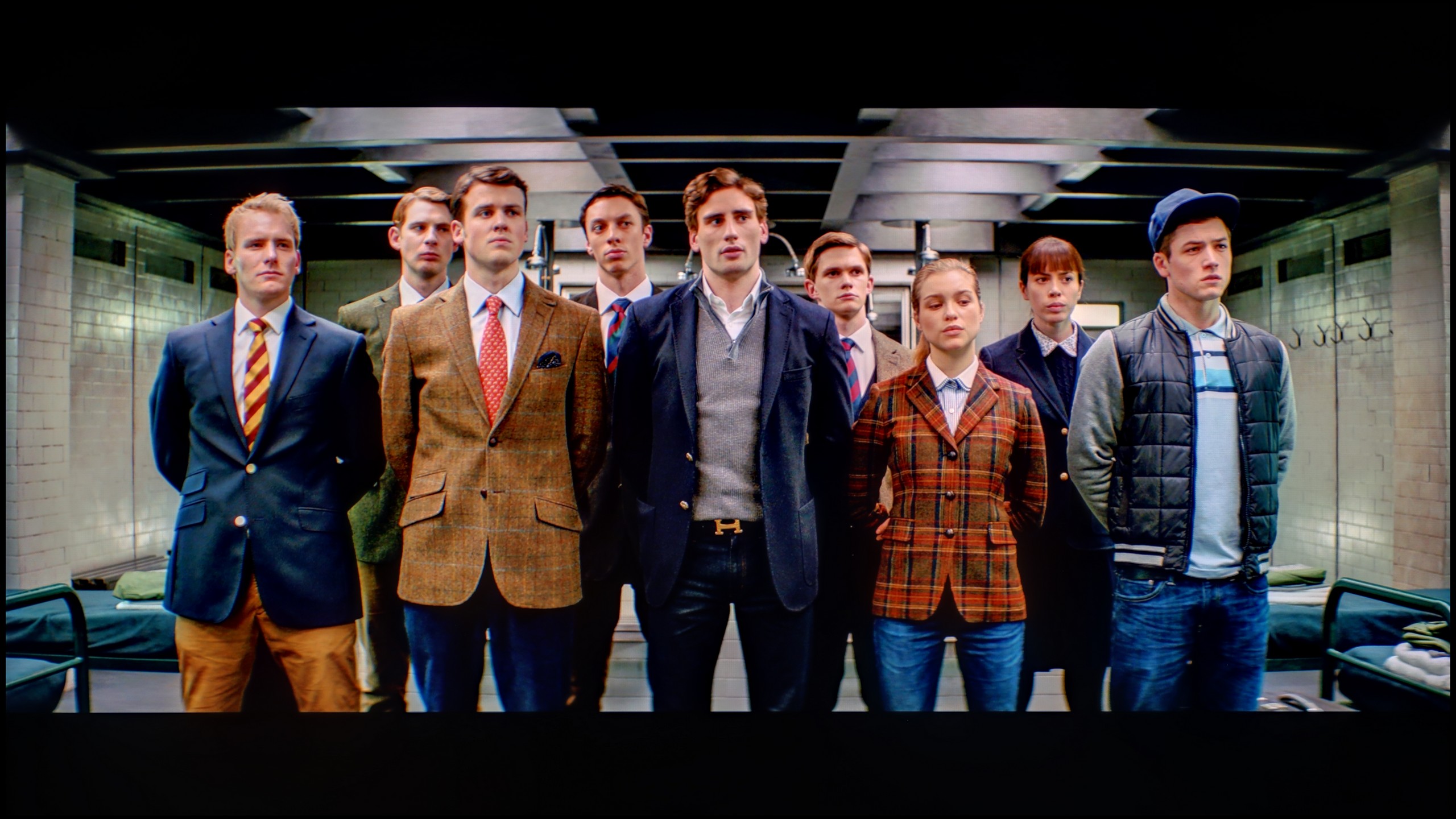


After professional calibration, the Filmmaker Mode showcases its full potential. The white balance in HD content is exemplary – errors at the level of 0.5 indicate almost perfect accuracy in colour reproduction. The image now appears natural, and the colours are exactly as they should be. In 4K HDR content, the effect is not quite as perfect, but it still maintains a really high standard. The colours are vibrant, well-saturated, and the overall image quality is impressive.
So where does the problem lie, given our praise for the colour reproduction? Unfortunately, the entire experience is disrupted by the brightness characteristics. The gamma in HD content looks decent, but in 4K HDR, it’s not as good. The EOTF curve shows that the television excessively brightens certain parts of the image, which is a result of design limitations. The lack of local dimming means that the television is unable to accurately control the differences between the brightest and darkest areas of the screen. This is a barrier that simply cannot be overcome in this model.
Nonetheless, after calibration, Samsung The Frame LS03D offers excellent colour reproduction, particularly in HD content, and the overall look is significantly better than before the settings were adjusted.
After professional calibration, the TCL C8K has made a huge leap forward. In SDR content, the white balance has been almost perfectly set – the screen has finally stopped being too warm and has taken on a neutral character. The gamma curve, which is responsible for how brightness is represented, now looks very good – the image is more coherent and realistic. In HDR content, we also improved the white balance – within the limits of what the television itself allows. Unfortunately, the C8K still interprets brightness management a bit "in its own way." When we look at the EOTF chart in films, it’s clear that the television brightens entire scenes more than it should. Before calibration, this effect was quite bothersome – now the situation is much better, although it still falls a bit short of perfection. This, however, is a limitation of the device itself, which – despite our efforts – does not allow us to fully tame its nature.
Smoothness of tonal transitions
9.7/10
8.7/10





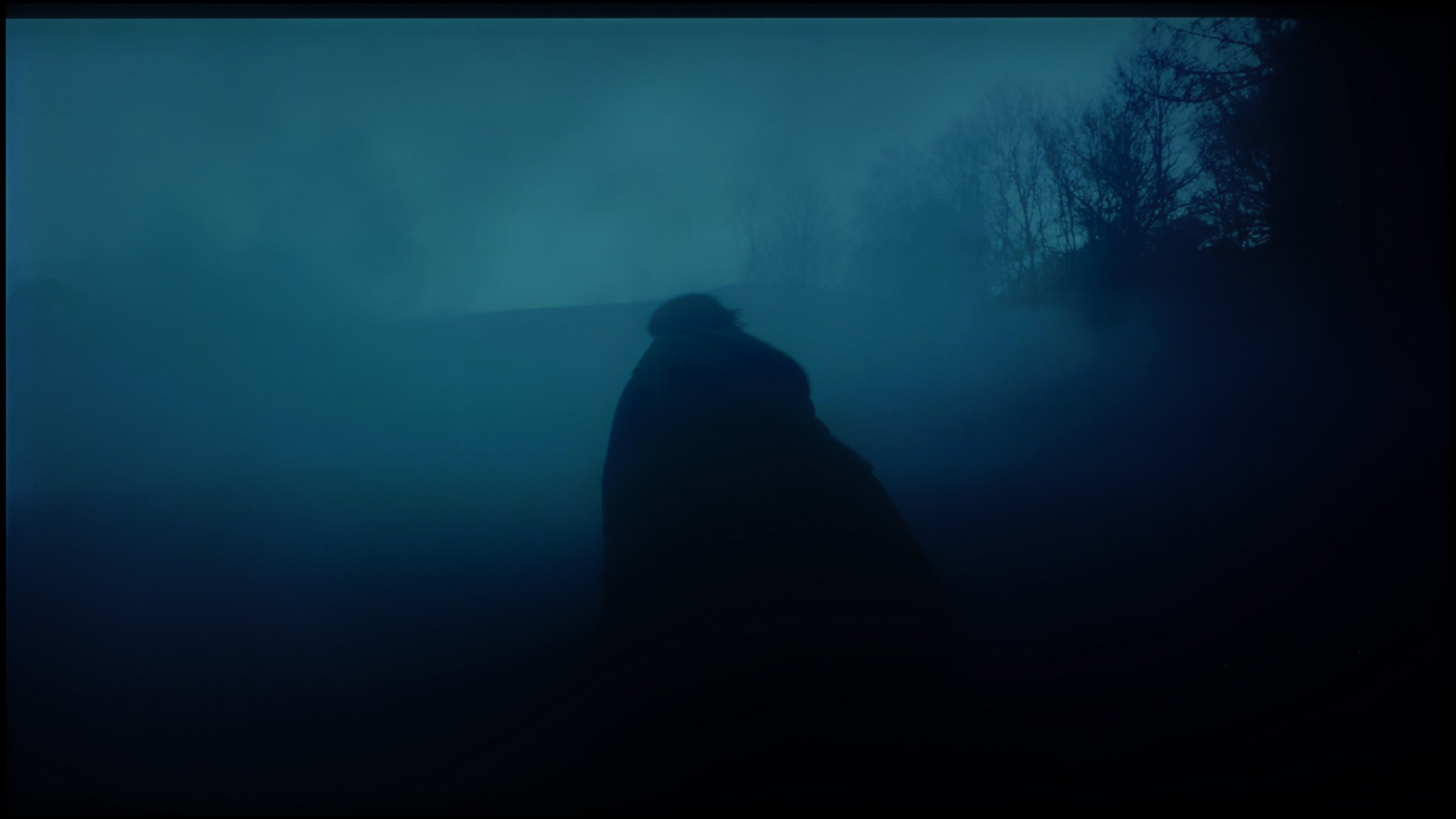






This is one of the best televisions we've had the opportunity to test in terms of the smoothness of tonal transitions. Any potential imperfections are so minor that you really have to strain your eyes to notice them. They are subtle enough that we only deducted a symbolic fraction of points in this category. Undoubtedly, this is one of the greatest advantages of this model. It's possible that such a good effect is partly due to the matte screen coating, which gently masks any irregularities in colour gradation. The smoothness of tonal transitions in Samsung The Frame LS03D is at a level that will satisfy even exceptionally demanding users. Kudos to LS03D!
In this regard, the TCL C8K performs really well. The transitions between colours look natural and cohesive – there are no strange bands or strong banding that could disrupt the viewing experience. Especially in bright scenes, everything looks very smooth. In the darkest parts of the image, particularly in shades of grey, you might occasionally notice slight inconsistencies, but they are subtle enough that they shouldn't bother anyone.
Image scaling and smoothness of tonal transitions
7.1/10
5.5/10
Smooth transition function

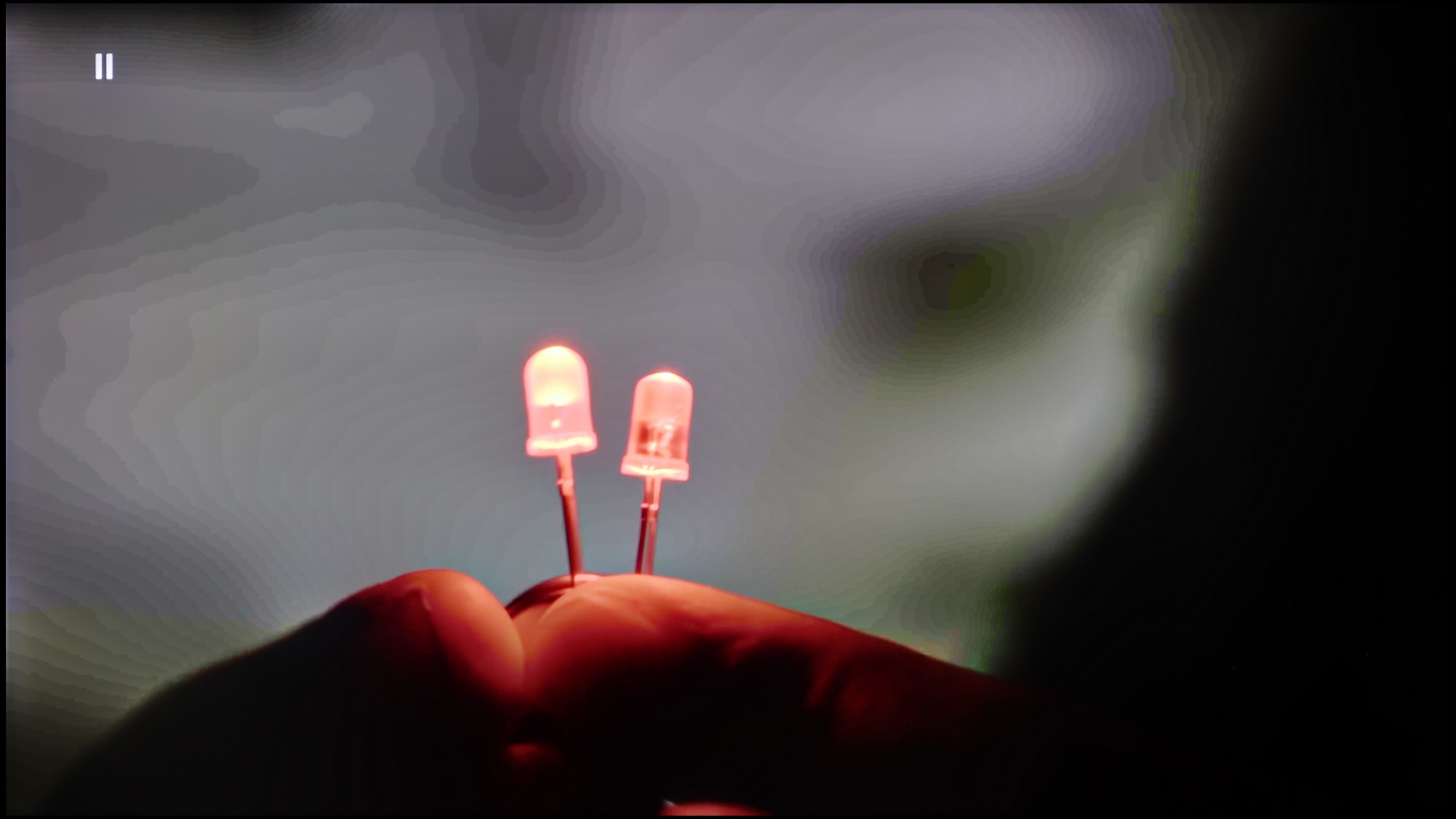
Image without overscan on the SD signal

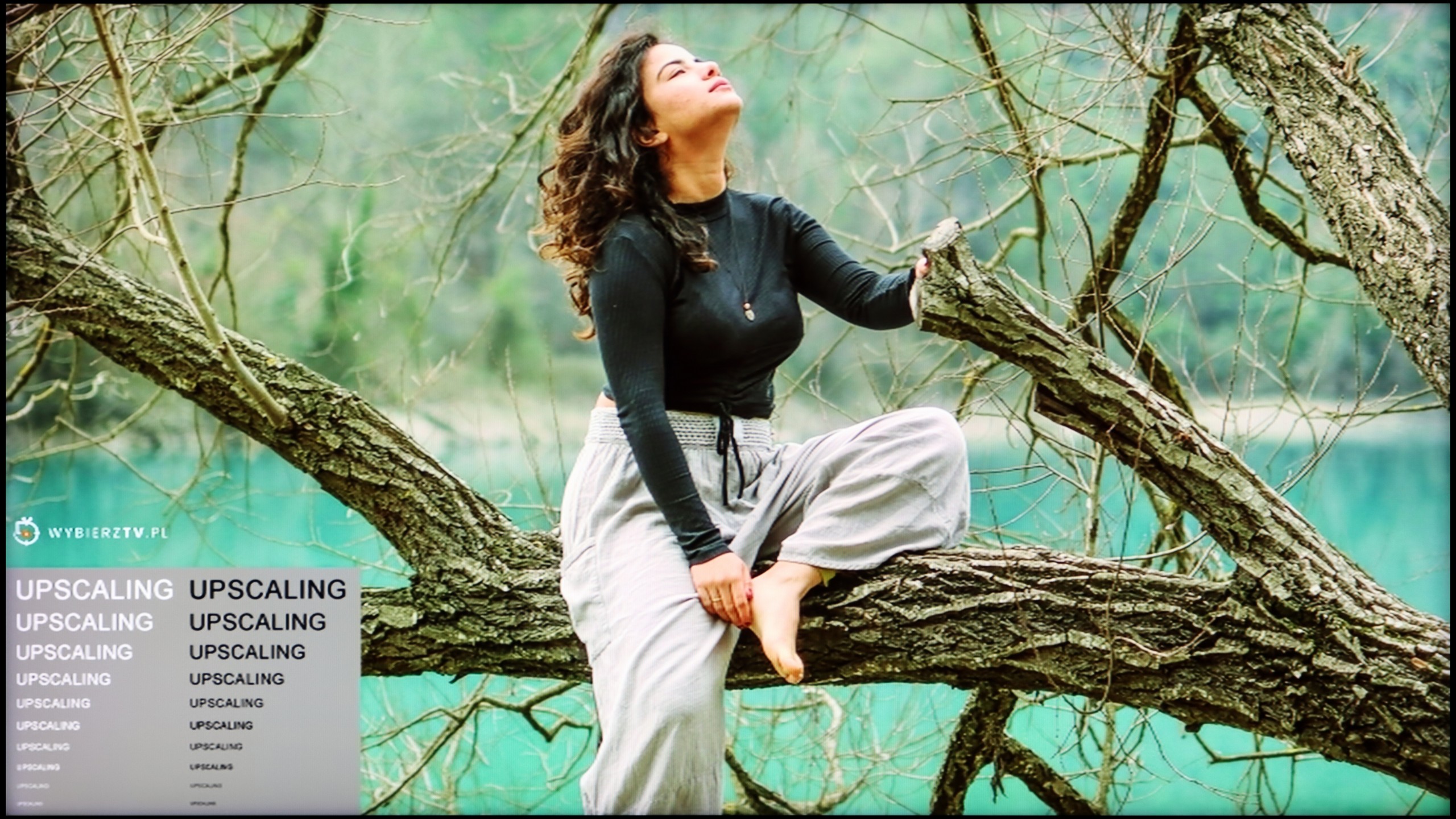
It's time to check how Samsung The Frame LS03D copes with older, lower-quality materials. We already know that the smoothness of tonal transitions is at a very high level, so we were curious to see how the TV would handle smoothing them out.
The noise reduction feature in the “Standard” setting does its job well – tonal transitions are noticeably smoothed out, and the image doesn’t lose too much detail. However, it’s worth noting that this effect also smooths out film grain, so its usage will be a matter of individual preference.
When it comes to image scaling, the TV performed really well too. The tested image came out solid – the model was accurately represented, with clear details. The branches in the background, although slightly frayed in places, generally look natural and do not stand out as a flaw.
How does the TCL C8K handle lower quality materials? One could say: fairly well, though without much enthusiasm. The television offers a tonal transition enhancement feature designed to smooth out unwanted gradients. In practice, there's a slight improvement visible, but it's not at a level that eliminates all imperfections. The feature subtly softens harsh transitions, but it doesn't work miracles. Film grain isn't completely suppressed, and subtle banding on grey backgrounds can still be noticeable. But maybe that's for the best? – at least the image doesn't lose its texture or depth, as is often the case with televisions that overdo digital processing. When it comes to upscaling, which is enhancing picture quality from lower resolutions, the C8K performs quite well. The image is sharp, and details – though sometimes a bit softened – remain discernible. However, it's not on par with the best picture processors from the competition. On the plus side, there's no issues with overscan, which is the artificial cropping of the image that can still surprise in some models from other brands.
Blur and motion smoothness
6.4/10
7.8/10

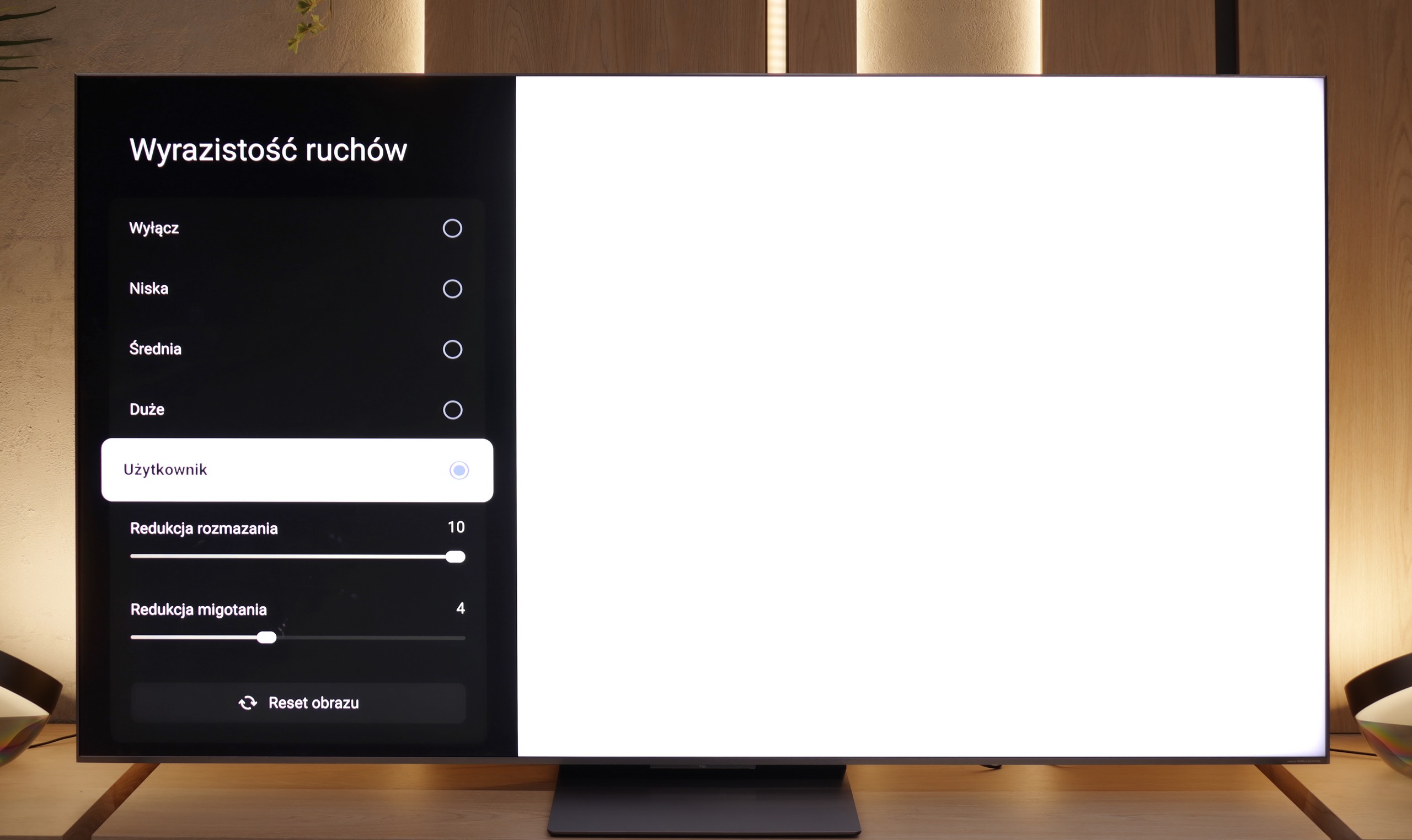
Blur (native resolution, maximum refresh rate):




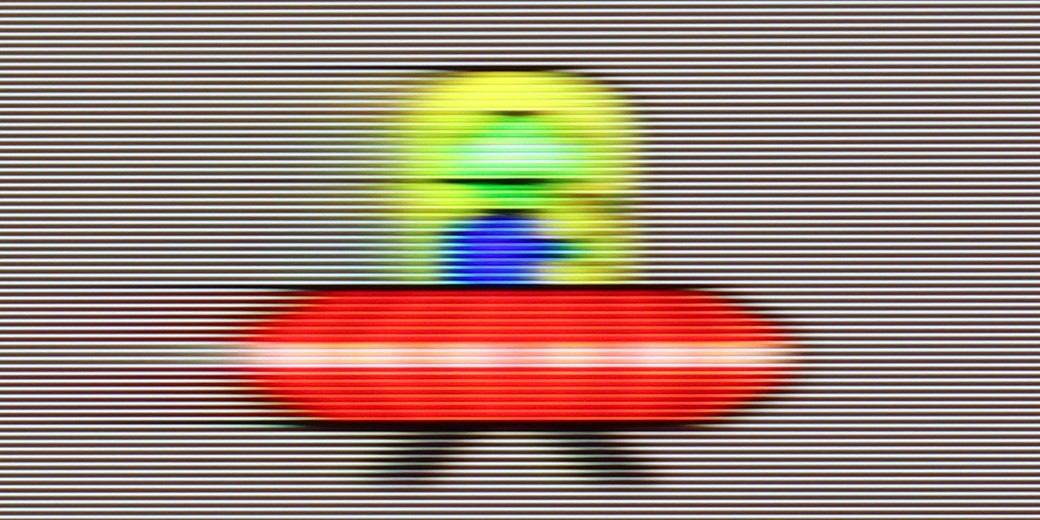
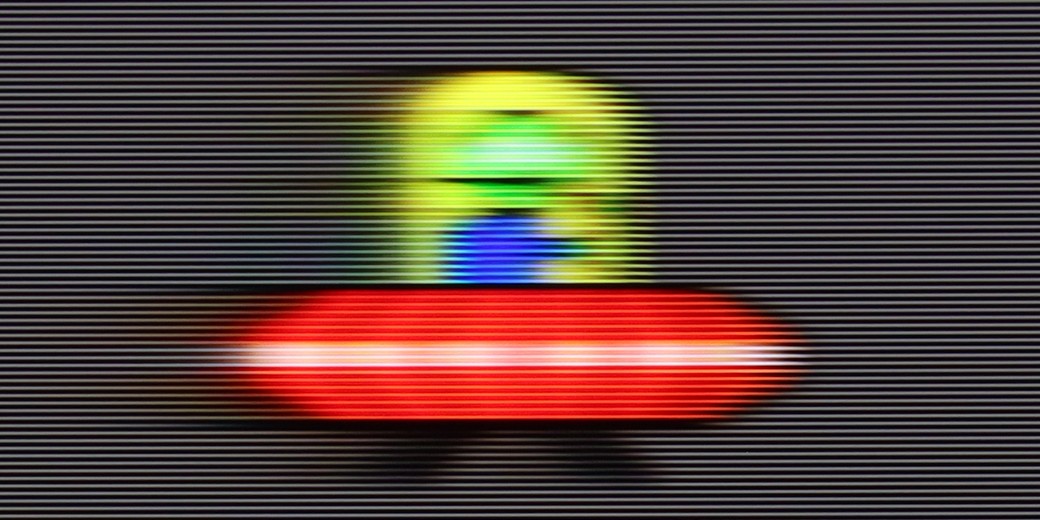
Blur (BFI function enabled):
Image flickers in this mode



Smużenie ():
Smużenie (288HZ 1080p):



To start off, it’s worth noting that the model we tested in the 55-inch size, along with the 65, 75, and 85-inch versions, is equipped with a 120 Hz panel. Unfortunately, the 43 and 50-inch variants of this series only offer 60 Hz panels, which is worth considering when making a purchase. In terms of improving motion fluidity, the TV offers a feature called “Image Clarity.” This is a classic motion smoother that gives users the ability to adjust using two sliders:
Blur Reduction – this controls image sharpening during dynamic scenes. The higher the value, the less blurring occurs during fast camera moves or moving objects. However, setting it too aggressively can make the image look unnatural and resemble a “soap opera.”
Judder Reduction – this slider affects the smoothness of frame playback, especially in materials with lower frame rates, such as movies (24 fps). Higher settings can smooth out motion but can also lead to excessive “plasticity” of the image.
Both sliders operate on a scale from 0 to 10, allowing for precise adjustment of the effect to personal preferences. It’s a good idea to experiment with the settings to find the perfect balance between fluidity and a natural look for the image. We recommend setting them as shown in the picture.
If you're planning a weekend with the Champions League or a marathon of F1 racing – the TCL C8K won't let you down. The television is equipped with a 144 Hz panel, so it should inherently handle fast motion well. And indeed – it performs very well. The fluidity of motion is at a very good level here, and the "Motion Clarity" feature with two sliders (blur reduction and flicker reduction) allows you to easily adjust the effect to your own preferences. Want to slightly smooth things out – no worries. Prefer a cinematic look – no problem.
Console compatibility and gaming features
8.8/10
9.8/10
- ALLM
- VRR
- VRR range48 - 120Hz48 - 288Hz
- Dolby Vision Game Mode
- Correct implementation of HGIG
- 1080p@120Hz
- 1440p@120Hz
- 4K@120Hz
- Game bar

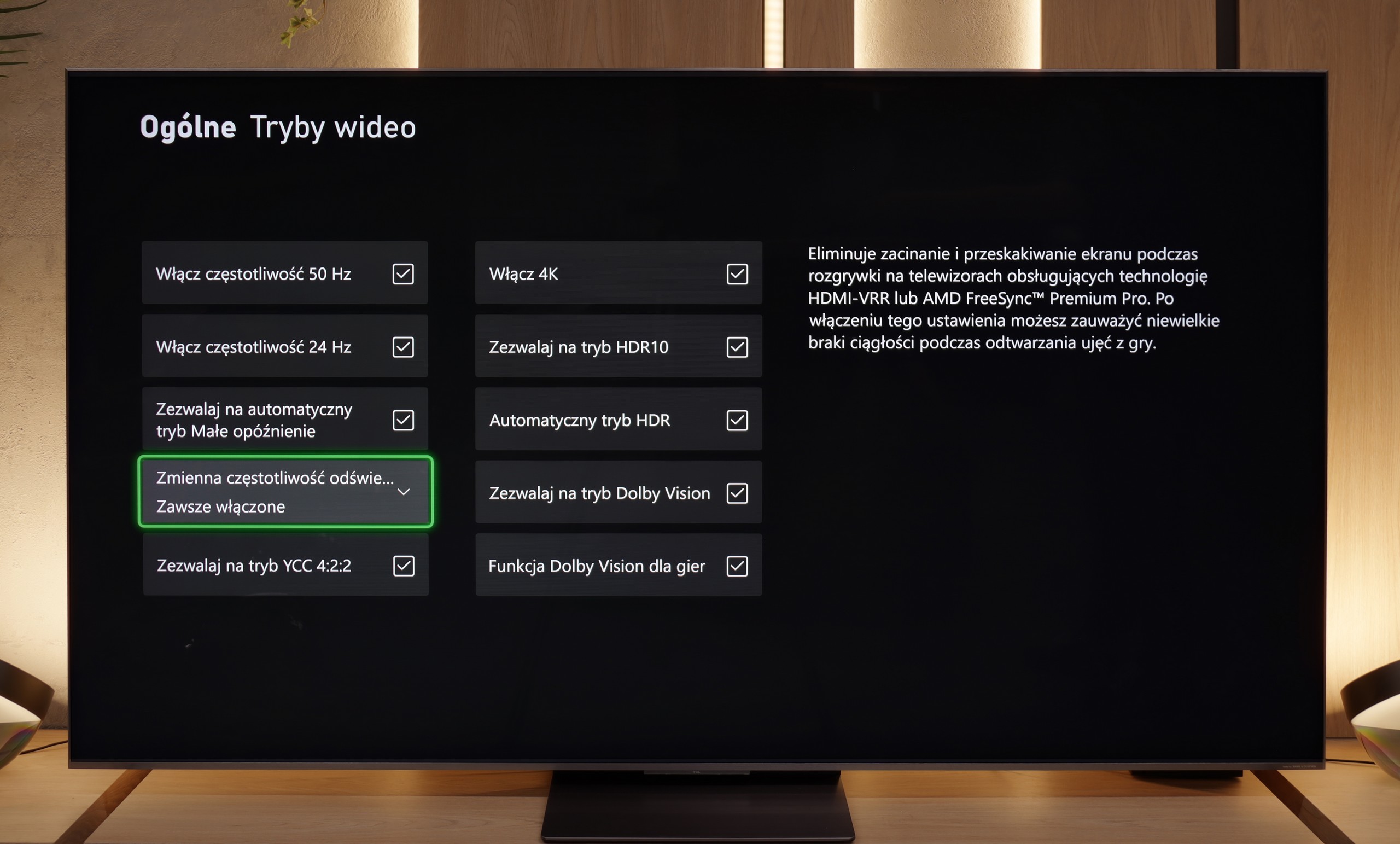

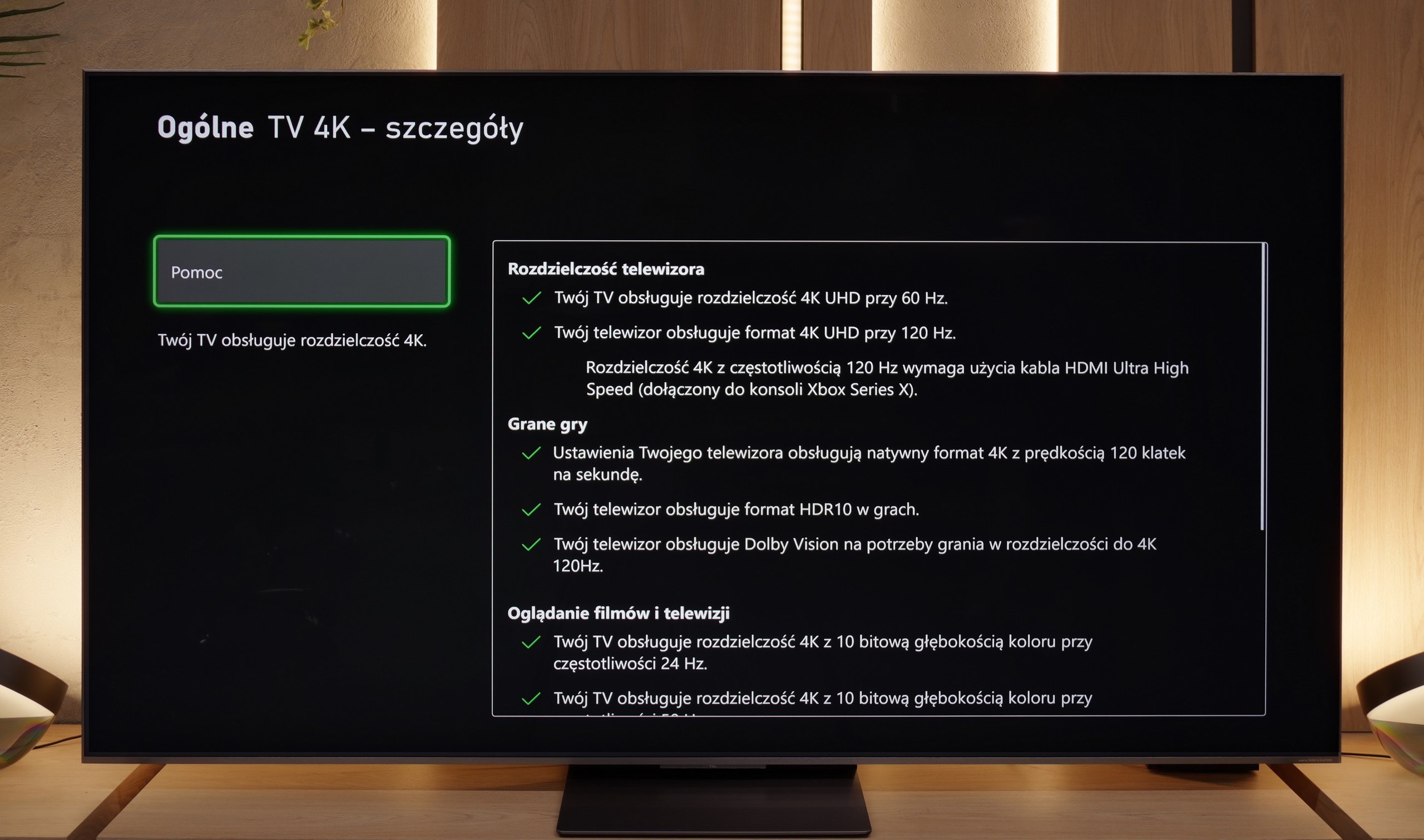

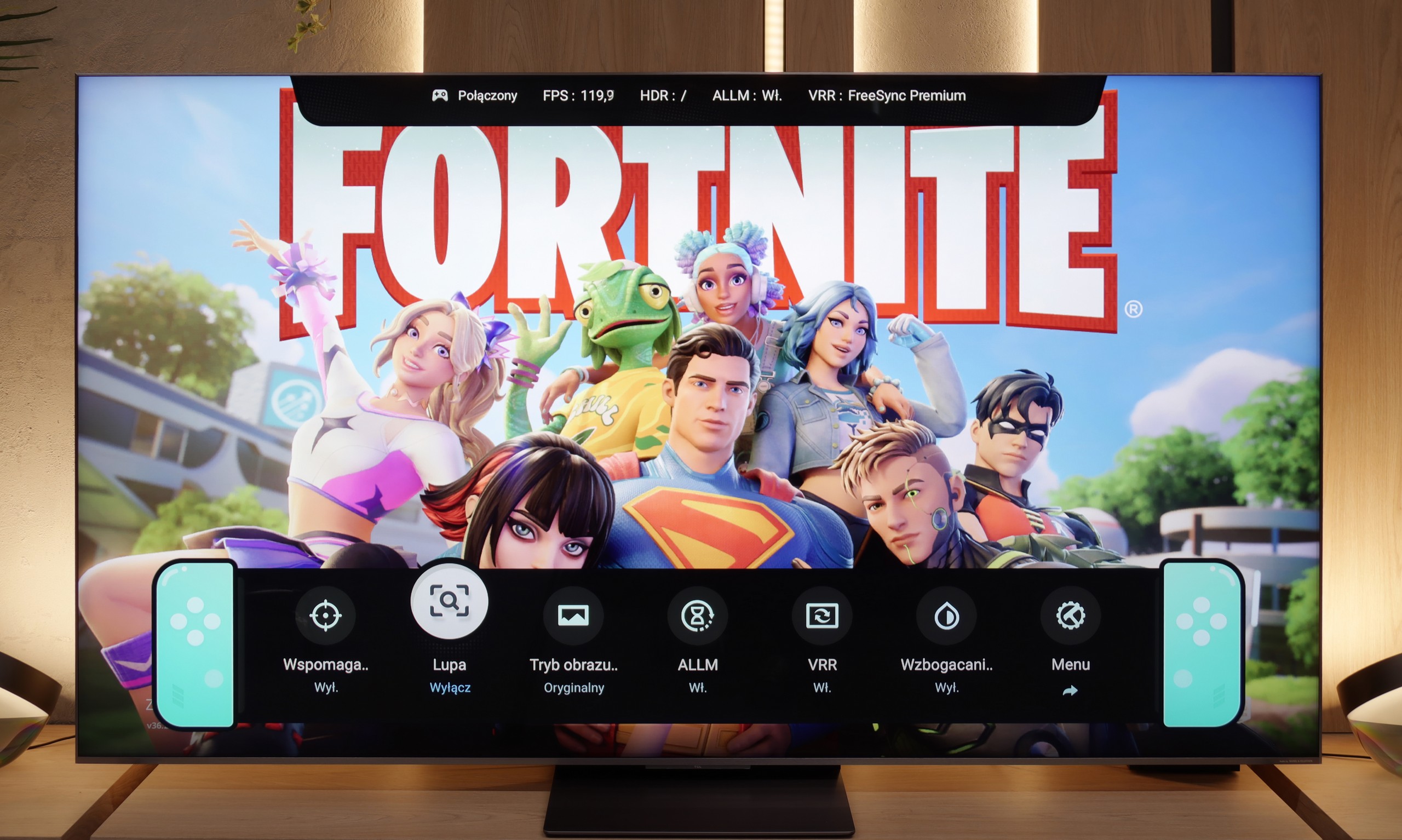

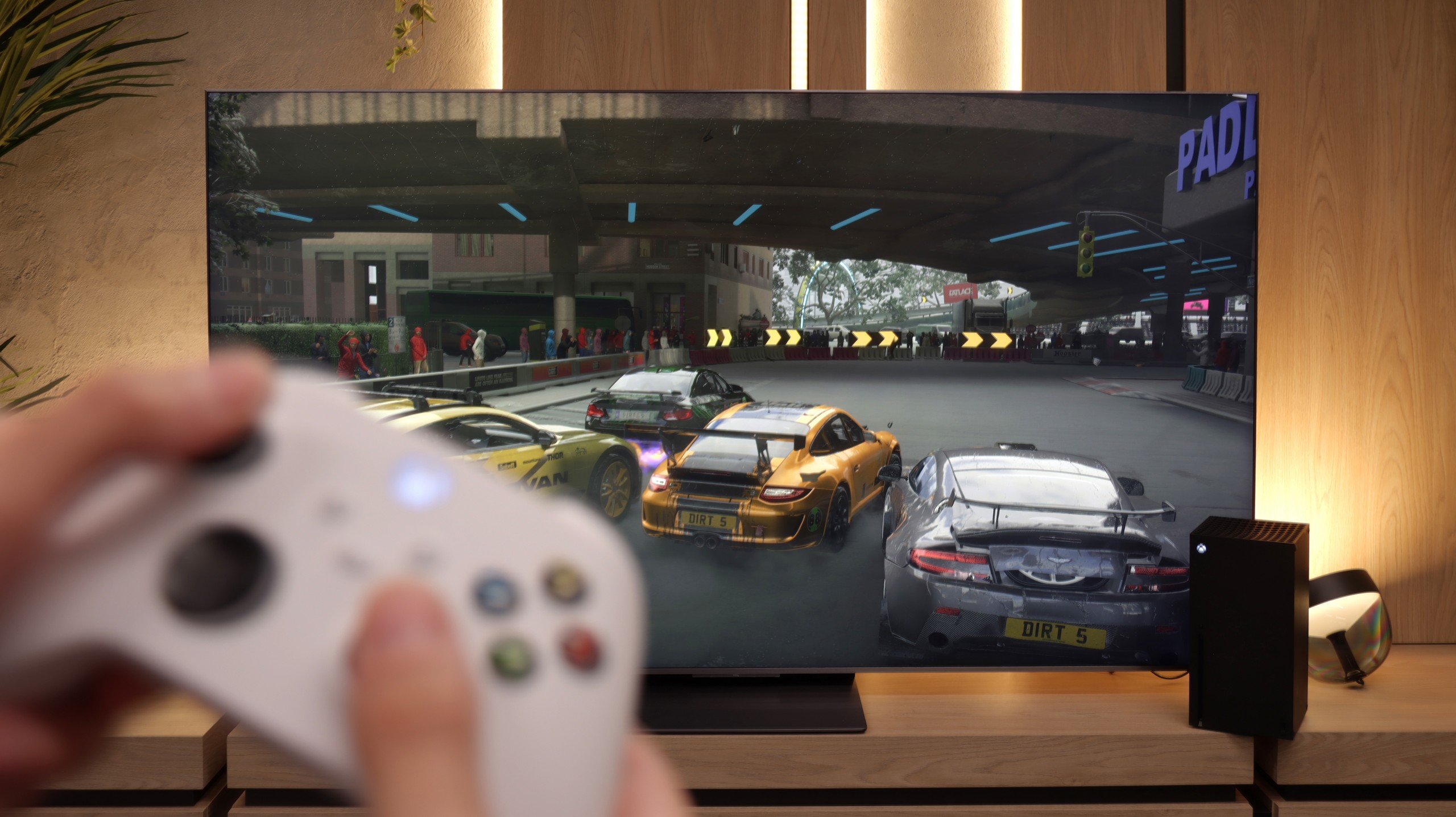
The Frame LS03D in the 2024 version is equipped with four HDMI ports, but only one supports the 2.1 standard with a bandwidth of 40 Gb/s. This is important information if we plan to connect more than one device that requires a 4K@120 Hz signal – for example, two consoles or a console and a gaming PC.
In terms of features for gamers, The Frame truly has a lot to boast about. We have ALLM (Auto Low Latency Mode), VRR (Variable Refresh Rate) and HGiG. It’s worth mentioning that HGiG has been very well implemented here, which is particularly important as the television does not support Dolby Vision in games (which is only available on Xbox consoles). In this case, HGiG turns out to be a better standard for gaming.
Samsung hasn't forgotten about features that enhance the gaming experience. Game Bar is an expanded panel for gamers that allows quick adjustment of screen settings without having to dig through the television menu. We can even change the aspect ratio from 16:9 to the panoramic 21:9, which can be a significant advantage for some gamers.
However, Samsung's biggest ace up its sleeve is the Game Motion Plus feature. This is a special smoother dedicated to games that adds additional frames of animation without significantly affecting input lag. The effect is really noticeable – the image seems much smoother, which will be particularly appreciated by fans of dynamic titles.
In summary – Samsung The Frame LS03D is a television that offers a solid set of features for gamers. Although the limitation to one HDMI 2.1 port may be a downside, the rest of the solutions make gaming on this television a truly enjoyable experience.
TCL C8K offers practically everything we could expect from a screen for gamers. It has variable refresh rate (VRR), automatic game mode (ALLM), Dolby Vision in games, and a well-functioning implementation of HGiG, which helps preserve the creators' intent in HDR titles. The TV also supports 120 Hz in lower resolutions without any problems, and it can even display a staggering 288 Hz in Full HD – a figure that will surely appeal to fans of dynamic shooters and sports games on PC.
On board, we also find the GameBar – a graphical interface that somewhat resembles an elongated Nintendo Switch console. Thanks to this, we gain quick access to information about the current game mode, frame count, HDR format, and other little details that really make life easier for the gamer. We obviously couldn’t resist and ran a couple of races in Forza Horizon on the C8K – and we must admit, it looked and worked really well.
However, there is a slight drawback – in such a fast and clearly gaming-oriented device, it's a bit unfortunate that the manufacturer opted for the implementation of only two HDMI 2.1 ports. For some users, who use several next-gen consoles and, for example, a soundbar with eARC, this could be a limitation that’s hard to overcome.
Input lag
10/10
9.9/10
SDR
HDR
Dolby Vision
When it comes to latency, The Frame LS03D truly impresses. 13 ms with 60 Hz content and 8 ms at 120 Hz are results that will satisfy even the most demanding gamers. Such low values make the reactions to controller movements almost instantaneous. In dynamic games like shooters or racing, every fraction of a second counts – here, Samsung LS03D performs superbly.
In terms of delays, the TCL C8K pleasantly surprised us. Whether we were playing in 4K at 60 Hz, 120 Hz, or even in Full HD with Dolby Vision – the input lag remained at a very low level. This is a rare sight, as many TVs lose their advantage here, especially with more demanding Dolby Vision GAMING picture settings.
Compatibility with PC
7.6/10
8.6/10

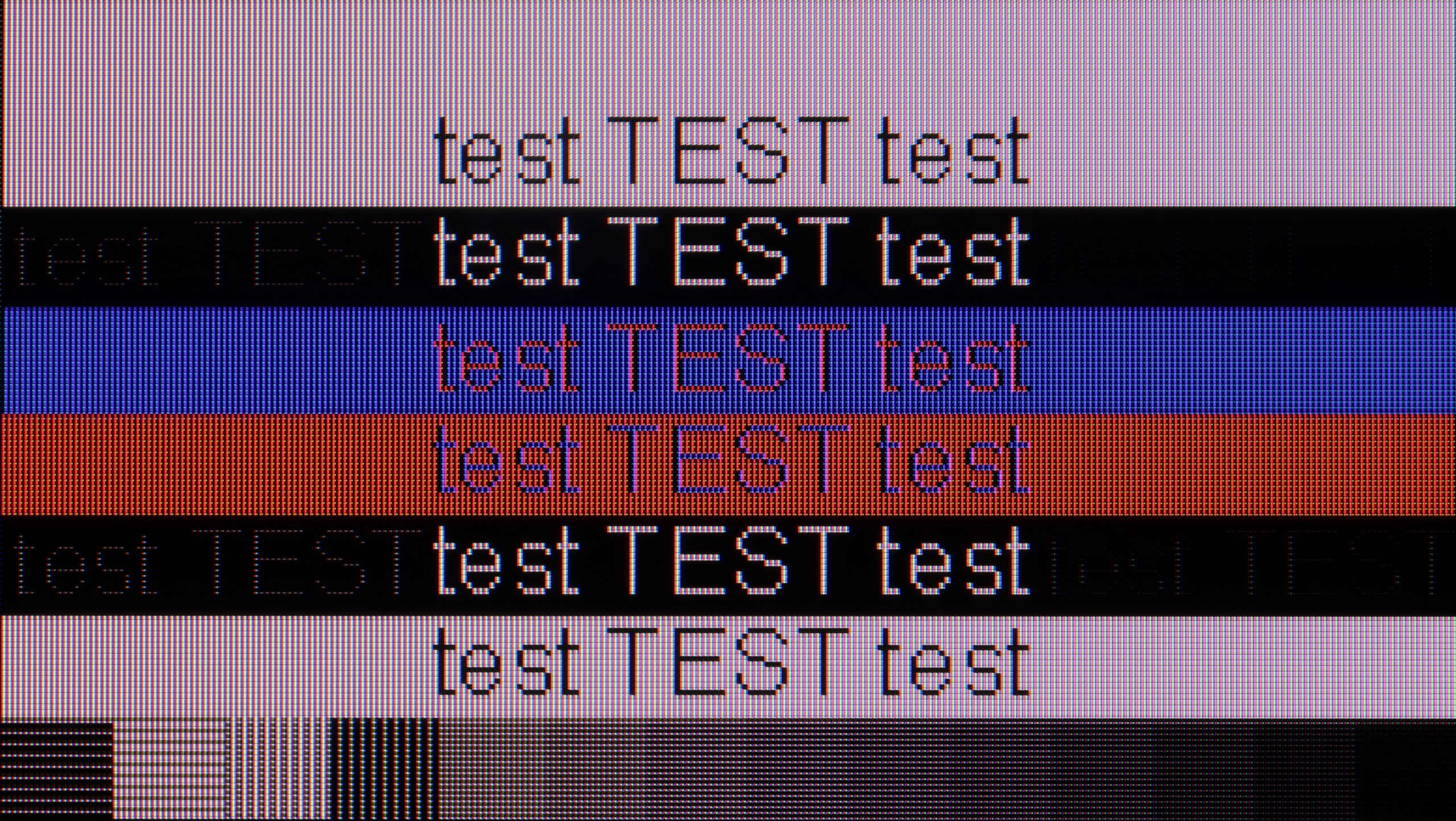
Using a computer on The Frame is truly a pleasant experience. The fonts are clear and well-reproduced thanks to the 4:4:4 chroma support. There's no blurring or fuzziness that often occurs in cheaper TVs. Of course, if someone is really scrutinising small texts, they might notice minimal imperfections, but that’s really a minor issue that doesn’t interfere with daily tasks. It's also suitable for gaming on PC. The 120 Hz panel, support for G-Sync, and really low input lag ensure that games run smoothly and without delays.
As we mentioned before, the C8K is a TV designed with gamers in mind – and not just console gamers. Connecting a PC is an absolute joy. The low input lag is practically unnoticeable, and the 4K panel at 144 Hz (or even 288 Hz in Full HD) makes gameplay exceptionally smooth. It's equipment that's really hard to pull away from when we connect a keyboard and mouse.
It also performs well for office work or everyday computer use. Fonts – regardless of size – are clear and sharp thanks to Chroma 444. However, we have a small note: with very thin horizontal lines, you can see slight imperfections. We assume that very few will notice this because, after all, hardly anyone plans to place the smallest 65-inch monster 50 cm from their face and use it like a regular monitor.
Viewing angles
3.3/10
4.5/10
The viewing angles on the Samsung The Frame LS03D are average, which is typical for a VA panel. And here lies a bit of a hitch – this television is supposed to serve as a display for images and artworks, which are not always viewed straight on. When viewed at an angle, colours begin to lose their intensity, and blacks turn into shades of grey. It isn’t a level that completely ruins the viewing experience, but if the television is set up in a spot where it will often be watched from the side, the effect may be noticeable. It’s a shame, because better viewing angles in a television designed for such a purpose would be a great advantage.
One of the innovations in this year's TCL series is the WHVA panel, which has finally made a step forward in terms of viewing angles for the Chinese manufacturer. And while you can't completely cheat physics – brightness does indeed drop noticeably when viewed from the side – the image itself remains clear and doesn’t drastically lose colours or contrast. This is a significant change, as VA panels typically fall short compared to IPS panels in this category. Meanwhile, in the C8K, it’s clear that TCL has made an effort so that even a viewer sitting a little to the side can still enjoy the full image – something that everyone who doesn't sit "right in the perfect middle of the sofa" will appreciate.
TV efficiency during daytime
6.5/10
6.9/10

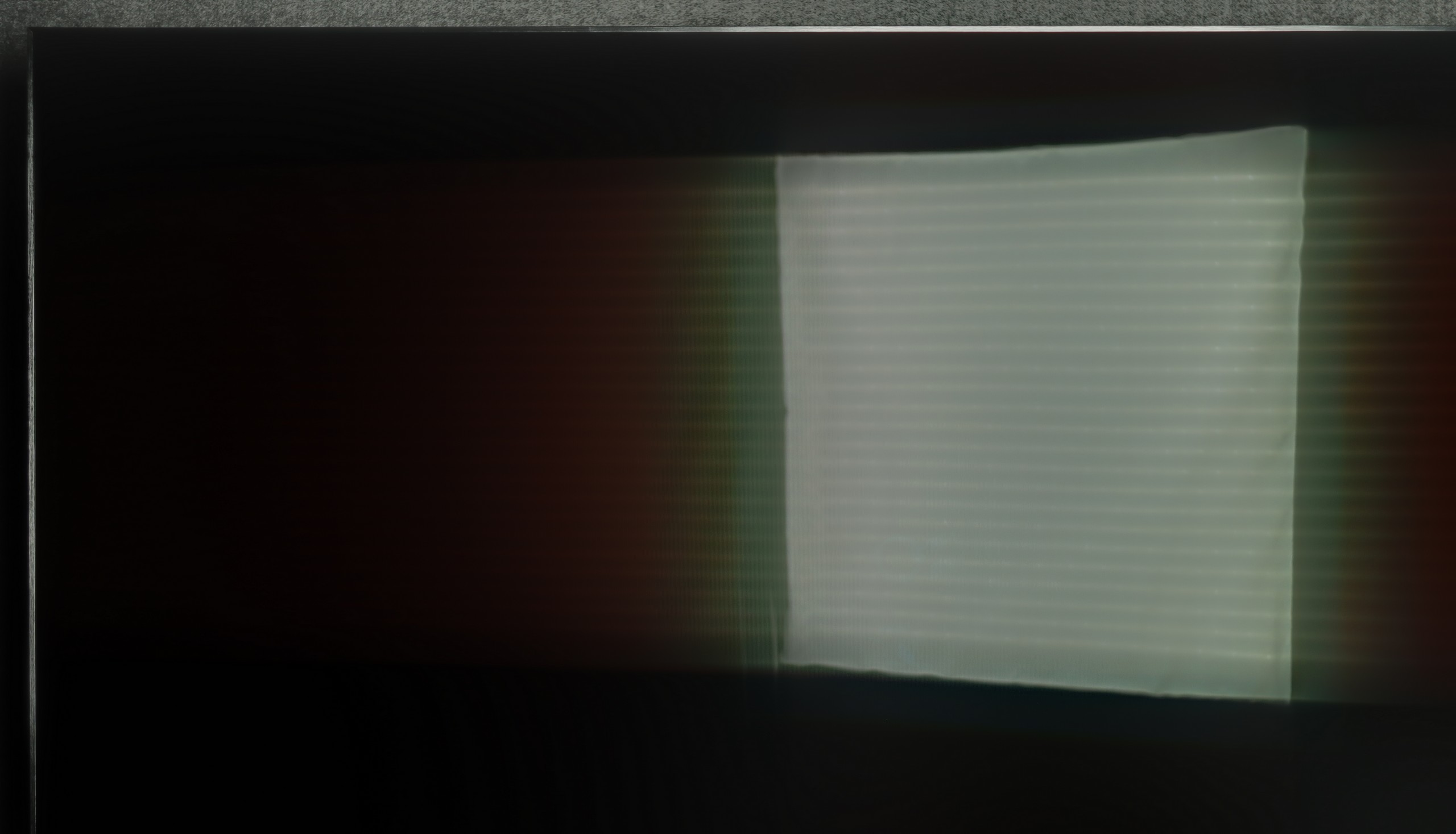


Matrix brightness
Average luminance SDR
TCL C8K: 613 cd/m2
Samsung The Frame LS03D : 645 cd/m2
Samsung The Frame has been equipped with a matte panel that effectively manages to reduce direct light reflections. This means that even in a brightly lit room, the image remains clear, and reflections do not interfere with viewing. Of course, as is often the case with matte finishes, there are trade-offs – colours lose some of their intensity, and black appears more washed out during the day. Fortunately, the television compensates for this with a brightness level of 650 cd/m². This ensures that the image is bright, sharp, and easily visible even in a well-lit room.
C8K is a really bright performer, and not just in theory. In SDR content, it can reach an impressive 700 nits, which translates to very good image readability even in brightly lit rooms. So if you have a bright living room with large windows – this TV won’t have much of a problem. However, it’s worth mentioning one little detail: the WHVA panel used here with improved viewing angles causes light reflections to be more diffused to the sides. In practice, this means that, for example, wall sconces or floor lamps directly opposite the screen may reflect in a slightly more extensive way than in typical glossy/satin panels.
Details about the matrix
Subpixel Structure:

Panel uniformity and thermal imaging:

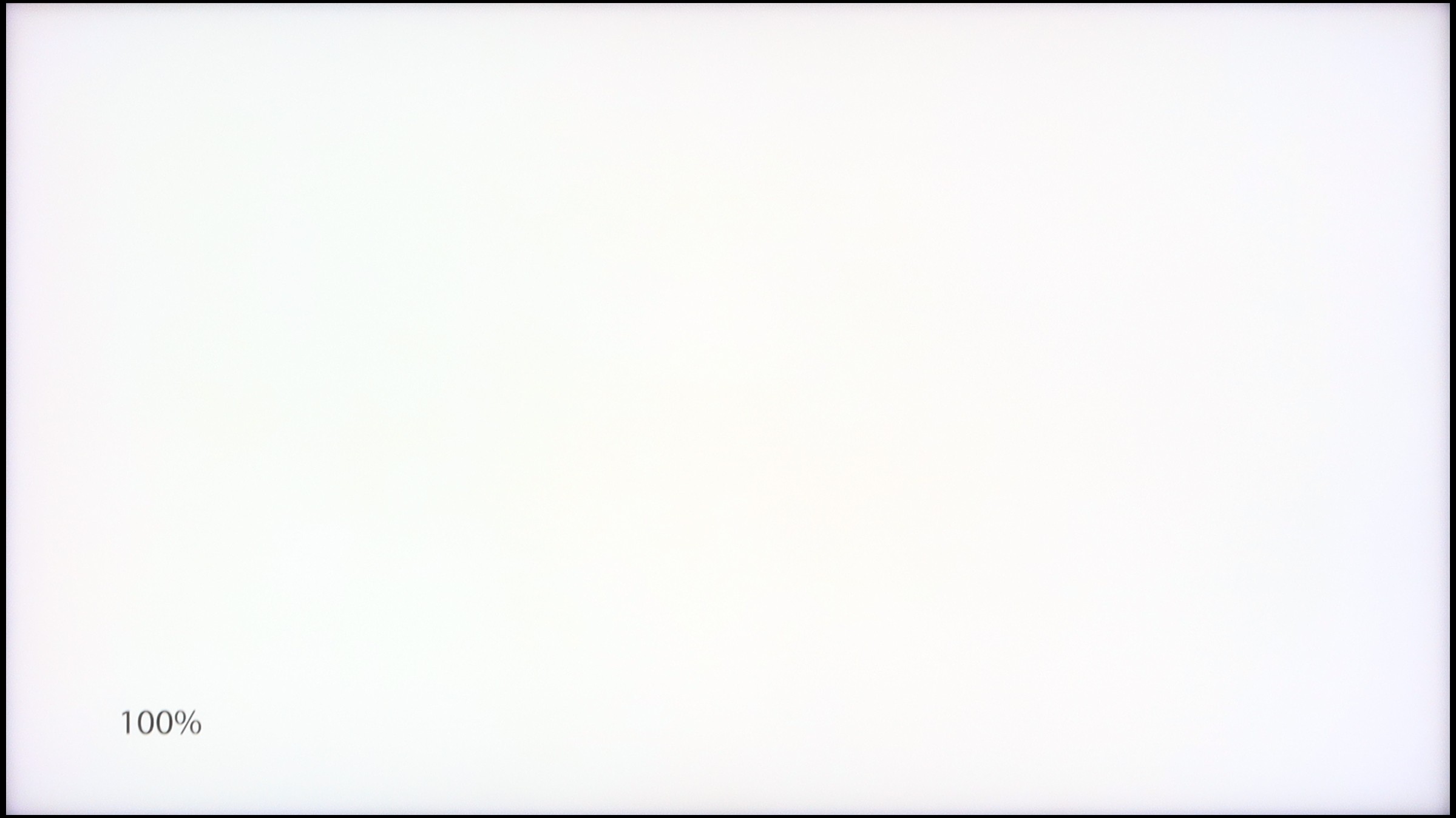
TV features
7.8/10
7.7/10
- HDMI inputs3 x HDMI 2.0, 1 x HDMI 2.1 40Gbps2 x HDMI 2.0, 2 x HDMI 2.1 48Gbps
- OutputsToslink (Optical audio), eARC (HDMI), ARC (HDMI)Toslink (Optical audio), eARC (HDMI), ARC (HDMI)
- Network InterfacesWi-Fi 2.4GHz, Wi-Fi 5GHz, Ethernet (LAN) 100MbpsWi-Fi 2.4GHz, Wi-Fi 5GHz, Ethernet (LAN) 100Mbps
- TV receptionDVB-T, DVB-T2, DVB-S, DVB-S2, DVB-CDVB-T, DVB-T2, DVB-S, DVB-S2, DVB-C
Classic features:
- Recording to USB (terrestrial TV)
- Recording programming
- Picture in Picture (PiP)
- RF remote control (no need to aim at the screen)
- Backlit remote control
- Teletext
- Audio only mode
- Bluetooth headphones support
- Simultaneous Bluetooth headphones & TV audio
Smart features:
- AirPlay
- Screen mirroring (Windows Miracast)
- Voice search
- Voice search in native language
- Ability to connect a keyboard and mouse




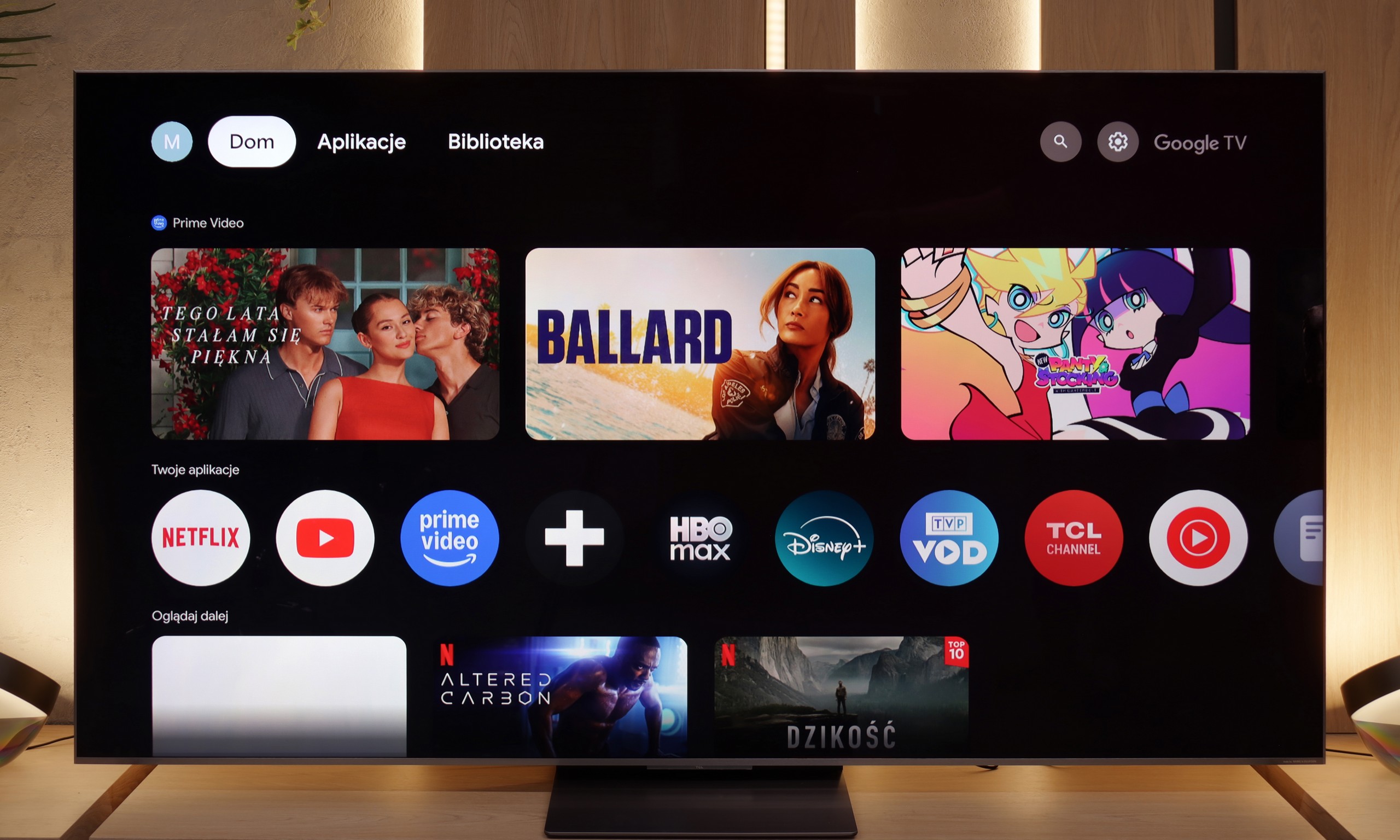
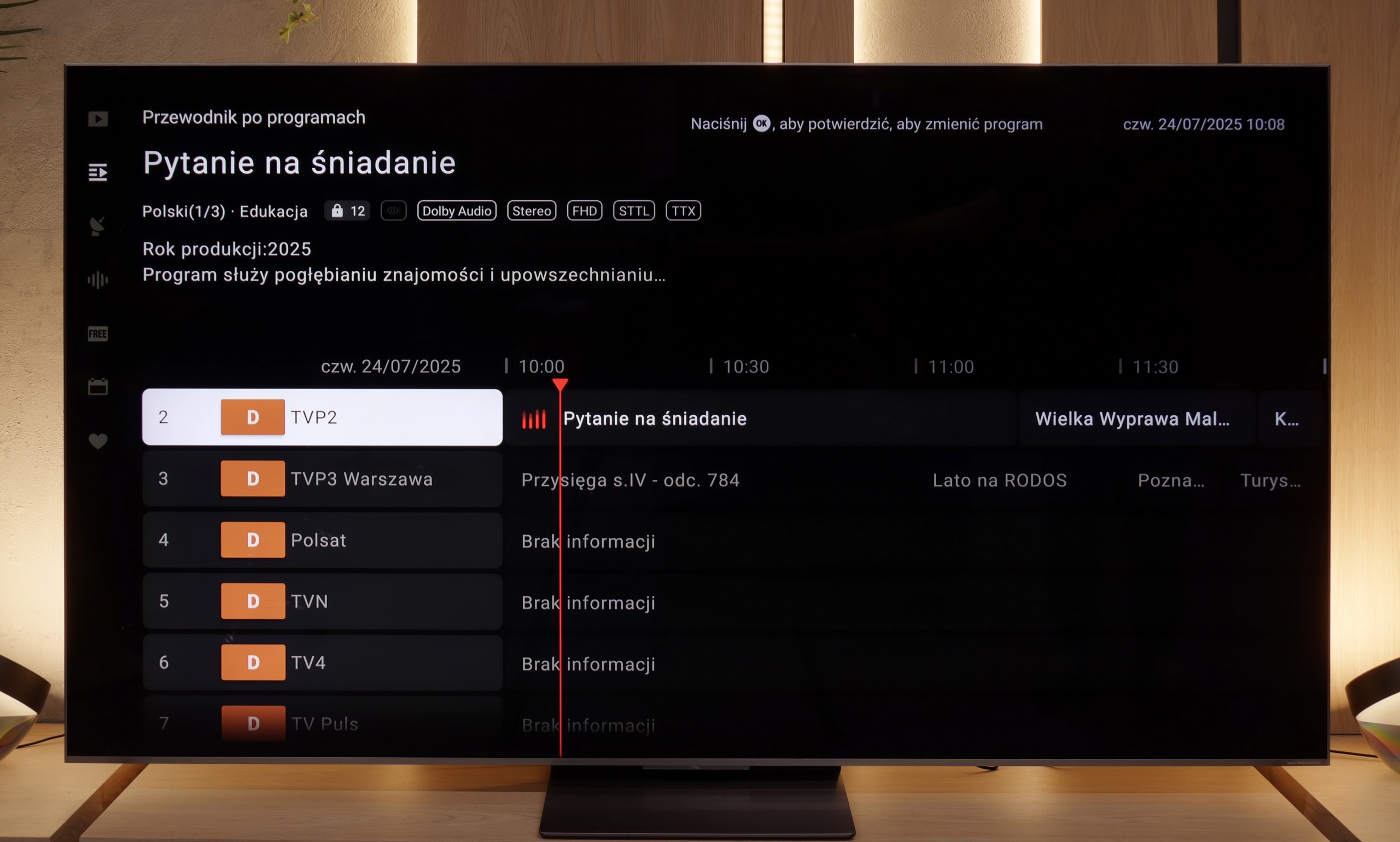
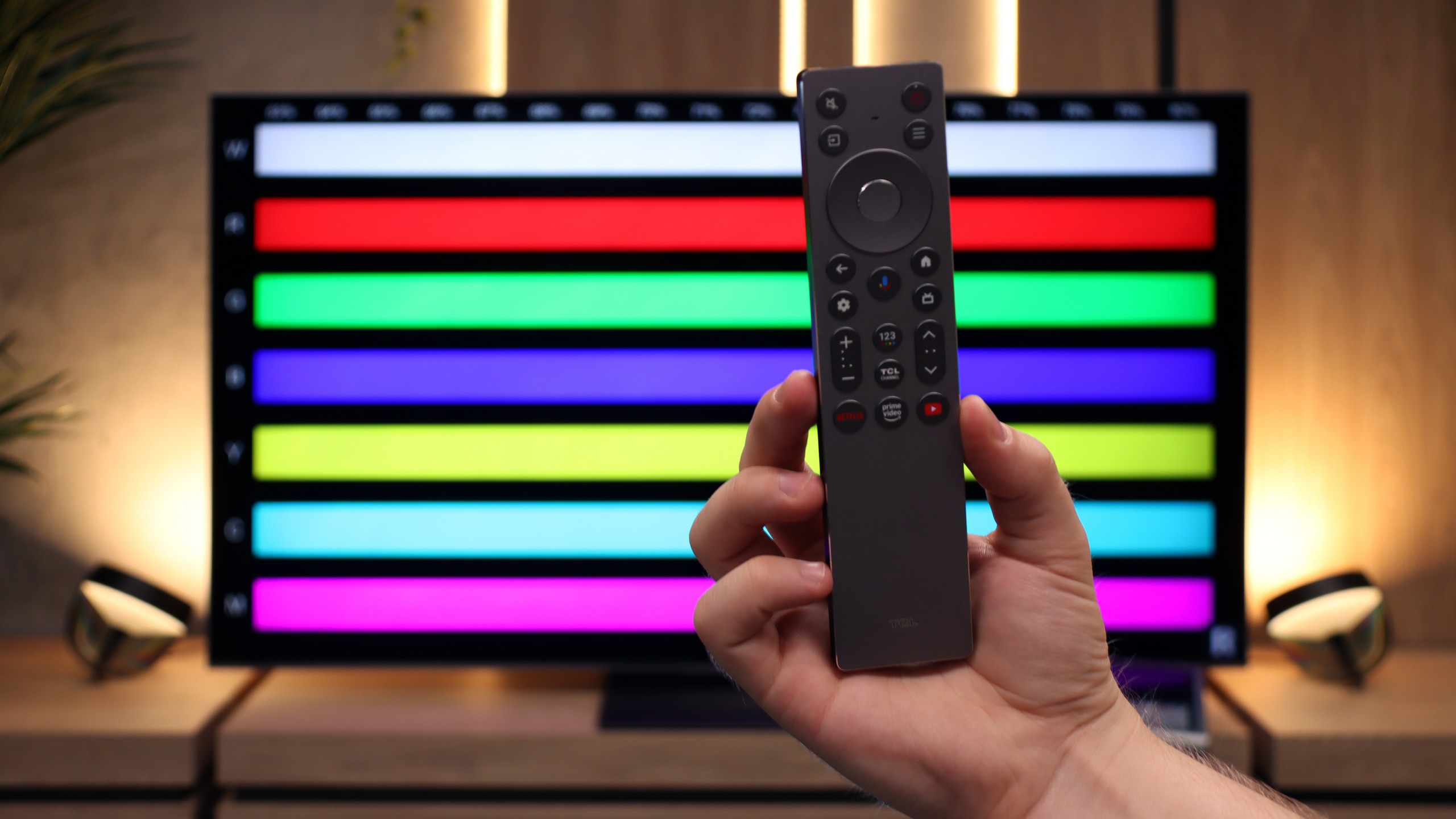
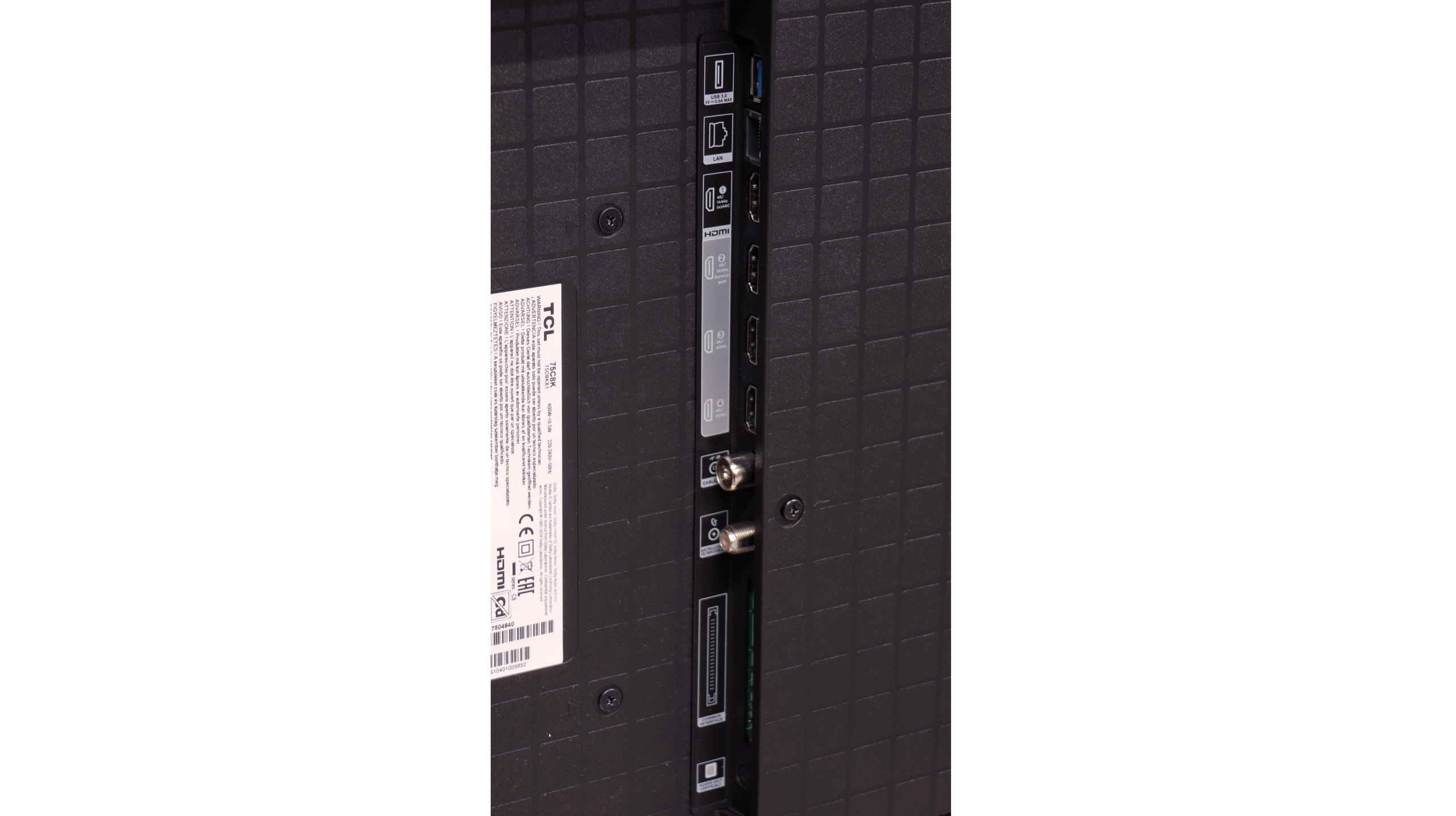
Samsung The Frame LS03D is a television that stands out from other models and is difficult to describe in a conventional way. Of course, it has all the standard Smart TV features thanks to the Tizen system. The system is responsive, comprehensive, and offers a wide selection of applications. The remote control supports voice commands in Polish, and we can connect additional devices via Bluetooth – just like in many other televisions. But that's not the essence of this model.
The biggest strength of Samsung The Frame is its design. The "Art" mode allows you to display thousands of high-resolution images, which, combined with the matte screen, look truly exceptional. The effect is surprisingly realistic and hard to compare to any other television.
The frames may not be the thinnest on the market, but they can be customised in terms of colour and style to perfectly match the interior. (Sold separately) And although the frames themselves are not ultra-thin, the entire construction is sleek and elegant. The wall mount, which is included (valued at about 400 PLN), is also worth noting. It allows the television to be mounted almost flush against the wall, with no gap, which further emphasises the "picture" effect.
And what about the cables? Samsung thought of that as well. The Frame is equipped with a One Connect module – this is an external box that connects all devices. Only one nearly invisible cable goes to the television, which carries both the signal and power. The box can be easily hidden in a cabinet or behind furniture, ensuring that nothing disrupts the aesthetic of the interior.
Samsung The Frame LS03D is more than just an ordinary television – it is a thoughtfully designed decorative element that combines modern Smart TV functionality with exceptional design and practical solutions. Although it lacks typical functions such as USB recording or PiP, it is not a model created with a conventional approach to television in mind. LS03D the frame is a television that is easy to love for its innovation, originality, and how well it fits into any interior.
Classic TV Features
TCL C8K offers the vast majority of features that we consider essential today. It has a classic and clear program guide (EPG), teletext functionality, and connecting a keyboard, mouse, or Bluetooth headphones was no problem at all. It's a bit of a shame that the Google TV system – like many other TCL models – lacks more advanced options such as program recording or picture-in-picture (PiP) functionality. For some users, this could be a downside, especially if they are used to these options with other manufacturers. There can also be some concerns about the number of USB ports – there is only one. However, in practice, most people will find this sufficient to connect a drive with movies or a USB stick.
Smart Features
While the classic TV features are not the strong suit of the C8K, when it comes to smart features, this TV really shows its claws. The Google TV system used is the largest and most popular platform on the market – and it shows at every turn. The availability of apps is phenomenal. Netflix, YouTube, Disney+, HBO Max, Amazon Prime – you can find all of these here without the slightest problem. Only really niche or closed ecosystems (e.g. Apple Music) may not be available. The built-in voice assistant works very efficiently – you can ask it to change the channel, launch an app, search for a movie, or check the weather. The system responds naturally and quickly, providing a genuine sense of convenience and modernity. This is where the C8K definitely outpaces much of the competition – after all, that’s why we have smart TVs, to do more than just display an image.
Playing files from USB
9.1/10
9.2/10
Supported photo formats:
Maximum photo resolution:

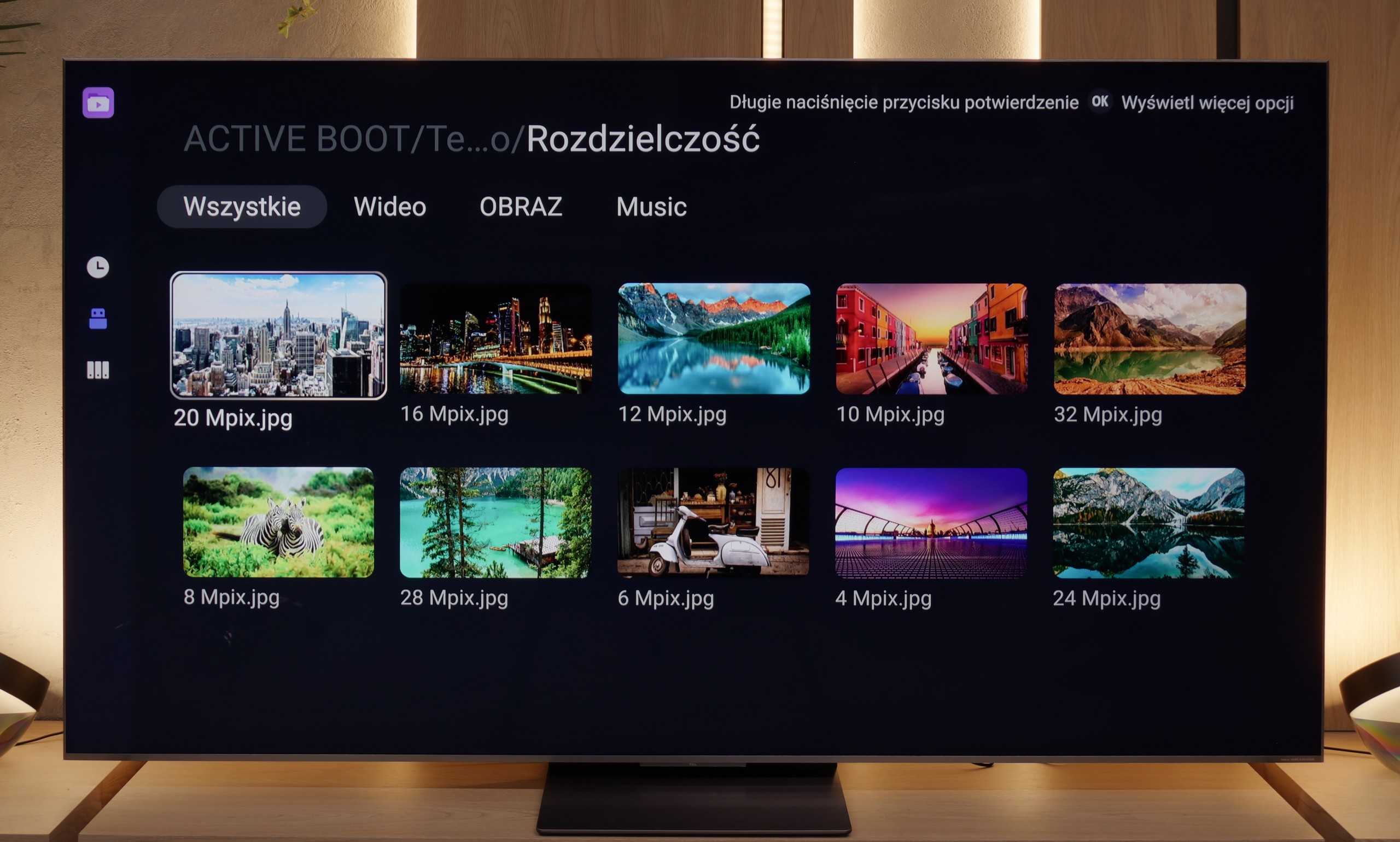
The built-in media player in Samsung The Frame handles most popular video and audio formats without any significant issues. Video files, even those with our added subtitles, play smoothly and without interruptions. The same goes for audio files – there are no major surprises here either. The handling of photo formats is somewhat less impressive. The built-in player has certain limitations and does not support all possible types of graphic files. However, nowadays most people use wireless photo transfer, so for many users this won't be a major problem.
We weren't expecting miracles, but... we got more than we anticipated. The TCL C8K handled most of the files we threw at it on the USB stick without issue. Movies in MKV, older AVI, audio tracks in DTS or AC3 – everything worked without a hitch. If we had to nitpick, it would be the usual complaint about the lack of support for the HEIC format from Apple devices, but that's a standard shortfall that one can live with. The most important thing, however, is that if someone is missing something, they can simply... install a better player. And this is where the advantage of Google TV is felt.
Apps
8.7/10
9.6/10














































Sound
5.8/10
7.9/10
- Maximum volume-77dB
- Dolby Digital Plus 7.1
- Dolby True HD 7.1
- Dolby Atmos in Dolby Digital Plus (JOC)
- Dolby Atmos in Dolby True HD
- DTS:X in DTS-HD MA
- DTS-HD Master Audio
The sound on Samsung The Frame is… well, quite average. The slim design of the TV, while impressive, doesn’t leave much room for decent speakers. As a result, the sound is flat and lacks dynamics – just like most TVs in this category. Samsung is clearly aware of this, as they have a special S series of soundbars designed specifically for their “lifestyle” TV line, which includes The Frame.
In terms of sound, we usually don’t have high expectations. After all, a TV isn’t a Hi-Fi system. But... the C8K positively surprised us. A new feature in the latest top models from TCL is the collaboration with Bang & Olufsen, and – most importantly – you can really hear that it’s not just a marketing gimmick. After just a few minutes with the TV, it was clear that it sounds different than a typical “flat screen”. The sound is full with a slight but noticeable bass. Of course, we’re still talking about sound from the television, so it won’t compete with the cheapest soundbar with a subwoofer, but for the standards of built-in speakers – it's very good.
*During loudness tests, we noticed unusual behaviour from the audio system. When the slider was set to 100%, the TV reached about 76–78 dB, but you could tell it was trying to generate more power, after which the volume level was immediately corrected to the mentioned value. On the other hand, when we lowered the volume to about 70%, it initially dropped as expected, but then slowly rose back to the same level of 76 dB. This effect gives the impression of an aggressive limiter at work, which, regardless of the position of the slider, always brings the volume back to one level. We checked this behaviour several times, and in every case, the result was identical – no additional “smart” volume adjustment or AI functions were activated.
Acoustic Measurements
No acoustic data
77dBC (Max)
75dBC
